
672 Wine Club
- Motorcycles
- Car of the Month
- Destinations
- Men’s Fashion
- Watch Collector
- Art & Collectibles
- Vacation Homes
- Celebrity Homes
- New Construction
- Home Design
- Electronics
- Fine Dining
- Aston Martin
- Dubai Tourism
- Gateway Bronco
- On Location – Olympic Games Paris 2024
- One&Only
- The Ritz-Carlton, Kapalua
- Royal Salute
- St. Regis Costa Mujeres Resort
- Sports & Leisure
- Health & Wellness
- Best of the Best
- The Ultimate Gift Guide
Boat of the Week: This Classic 70-foot ‘Gentleman’s Yacht’ Is All High-Tech Beneath Its Wooden Skin
The spirit p70 looks like a boat from the 1930s, but its list of modern technologies includes lithium batteries to power the house systems., howard walker, howard walker's most recent stories.
- Meet the Bugatti Tourbillon, the 1,800 HP Hybrid Hypercar Replacing the Chiron
- This 112-Foot Superyacht Has an Interior That’ll Make Your Manhattan Condo Jealous
- This 1967 Shelby GT500 Has Been Reimagined to Perfection. Now It’s up for Grabs.
- Share This Article

Spirit Yachts ’ flagship P70 may look like an extra from The Great Gatsby , but this oh-so-elegant wooden motoryacht, with its gleaming mirror-varnished mahogany and classic flag-blue paint, is new from the keel up.
The 71-footer was built by Britain’s Spirit Yachts for an experienced Norwegian owner who fell in love with the timeless lines of the company’s classic wooden sailboats, but wanted the style to translate to a powered yacht.
Related Stories
Hinckley’s newest picnic boat leads with a plush lounge up front.
- Paris Airports Have Undergone Major Overhauls Ahead of the Olympics
This Giant 438-Foot Gigayacht Concept Comes With Its Own Nightclub and Piano Lounge
If the Spirit name sounds familiar, this was the builder that has enthusiastically supplied yachts for Daniel “007” Craig to sail in those epic James Bond romps Casino Royale, and the newest, No Time to Die.

Note the beautiful grain of the quarter-sawn sapele mahogany on the exterior. Courtesy Spirit Yachts
But according to Sean McMillan, Spirit Yachts founder and chief designer, the owner didn’t simply want a classic-looking cruiser with a retro Roaring Twenties vibe that would sit at a marina. He wanted a boat that could go places. “The brief was to build a motoryacht capable of cruising from Britain’s south coast, across the North Sea to the Baltic and on to Norway, at an average speed of 18 knots. And he wanted the boat to go there and back—that’s over 1,000 miles—without having to refuel,” McMillan told Robb Report .
To meet the challenge, McMillan and a dedicated team of eight woodworking craftsmen, turned to the same wooden boatbuilding techniques they use to craft Spirit’s range of classic sailboats, including the recently launched 111-foot masterpiece Geist . That involved creating a framework using tough sapele hardwood. To this, longitudinal strips of Douglas fir were screwed and bonded to build the hull shape. Then, on top of this, multiple layers of Japanese kaya wood were glued diagonally to deliver carbon-fiber levels of strength and rigidity.
“It creates a hull that is immensely strong and light. The P70 weighs just 24 tonnes, which is almost half the weight of similar-sized fiberglass counterparts,” explains McMillan.

The lines have a retro feel, but the boat was designed to be a fast ocean-runner, capable of reaching 29 mph, but able to run in rough seas. Courtesy Spirit Yachts
Lighter weight also allowed smaller than usual engines to be mounted in the P70’s over-sized engine room. The twin 800-hp six-cylinder MAN turbo diesels are capable of delivering a top speed of 29 mph, with cruising at a more relaxed 20 mph.
Without doubt, it’s the lines of this timelessly elegant 1930s-style “gentleman’s” motoryacht that sets it apart. But the process of creating such a head-turning profile wasn’t easy. The owner, a highly experienced and knowledgeable boater, had firm ideas on what he wanted. It resulted in McMillan modifying the design more than a dozen times.
“He really liked the style of some of the Spirit power boats I’ve designed over the years. So, we combined the flared bow and tumblehome stern from our Spirit P40 with the 1930s style of our sailing yachts, and applied it to a larger motoryacht design,” he explains.

The main salon. Courtesy Spirit Yachts
The result is nothing less than a piece of floating art, with a classic slender waist—the beam spans just 16.5 feet—and that tall, proud bow. And there are some lovely classic design features, like the stainless-steel engine vents on the cabin sides that were inspired by those from a classic ‘50s Mercedes-Benz 300SL.
“To keep the sleek, uncluttered look, we did away with the typical stainless handrails, and lowered the level of the deck to make it safe and easy to walk around the yacht,” says McMillan.
Below decks, the slightly unconventional layout requested by the owner includes a central wheelhouse, a rich, leather-lined salon area forward, and a spacious galley and dining area aft. And on the lower levels, the master suite is in the bow with twin guest cabins at the stern.

The outer helm on the flybridge leads into the main wheelhouse a few steps down. Courtesy Spirit Yachts
The quality and attention to detail are exceptional. You can understand why it took a team of three painters almost seven months to varnish the bare-wood interior. From start to finish, building the yacht at Spirit’s yard in Ipswich, on Britain’s east coast, took almost three years.
But while the P70 looks classic and elegant in its design, beneath the skin it’s packed with some of the latest maritime technology. That includes a bank of lithium-ion batteries that can power the yacht’s air conditioning and zero-speed stabilizers while at anchor overnight, without cranking-up the generator.
“Wooden motoryachts like this are the future,” says McMillan. “They’re light, sustainable, have a great strength-to-weight ratio, are highly fuel-efficient, and, as our P70 shows, can be turned into things of real beauty.”

It took three painters seven months to varnish the interior. Courtesy Spirit Yachts
The price of a new P70 starts at £4 million, or roughly $5.5 million.
Read More On:
- Motor Vessel
- Sailing Yacht
More Marine

The Lounge on This New 90-Foot Yacht Turns Into a Driving Range at the Touch of a Button

These Boat Clubs Make It Easy to Cruise in Yachts, Sportfishers, and More

Meet the Wine Club That Thinks Differently.
Receive editor-curated reds from boutique California producers four times a year.
Give the Gift of Luxury
Latest Galleries in Marine

Ladenstein 88 in Photos

‘Honey Fitz’ in Photos
More from our brands, gap inc.’s richard dickson to be honored by the elizabeth taylor aids foundation, angel reese to join unrivaled 3-on-3 hoops league, dick asher, veteran music executive who fought radio payola, dies, barnes foundation cuts 12 positions, fires curator in newly created role, the best yoga mats for any practice, according to instructors.
- Yachting World
- Digital Edition

Spirit Yachts: Inside the British yard behind some of the world’s most beautiful boats
- February 6, 2020
Few builders possess the power of seduction demonstrated by British wood epoxy experts Spirit Yachts. David Glenn reports

Spirit Yachts’s workforce with one of the laminated sapele frames of the Spirit 111. Photo: Emily Harris
Today, Ipswich-based Spirit Yachts is embarking on a new phase in its development, having recently launched a 111ft sailing yacht that exploits the benefits of electric propulsion, the latest high voltage lithium battery technology and smart control systems to reduce the need for fossil fuel power.
Like all Spirits, she was constructed in timber from sustainable sources and because of her light and easily driven hull she could potentially become one of the most efficient sailing yachts afloat. On the face of it she’s an eco-warrior’s dreamboat, which means she was scrutinised down to her last plank of Douglas fir before her launch last year. But more of her later.

A joiner marking out a below waterline area. Photo: Emily Harris
In spite of a full order book, Sean McMillan, founder of Spirit Yachts, whose distinctive design style and inherent skill as a woodworker are responsible for these luscious-looking yachts, is the first to admit that it hasn’t always been an easy ride: “It’s been a roller-coaster, but it’s also been a great experience,” he says.
McMillan’s passion for wooden boatbuilding, and dogged determination to retain a highly skilled workforce through thick and thin has put him and Spirit at the very forefront of modern wooden yacht building.
Raising the profile
Five years ago the Ipswich-based company was facing a tough market as the ripple effect of the 2008 financial crisis continued to hobble business. Refit came to the rescue, but only up to a point. “I knew that we could not afford to lose staff,” said Sean, who has always placed his boat builders at the heart of Spirit’s success.
Article continues below…

Spirit Yachts 52D: This stripped-back racer is a wolf in sheep’s clothing
It may have been high season on the Solent, but among the eclectic mix of race boats both big and…

Oyster 565 yacht test: This bluewater cruiser marks the rebirth of a legend
For the sake of this iconic British brand, the new Oyster 565 can’t just be good, it has to be…
The directors also realised that running the company and designing the yachts (as well as not being able to resist some hands-on boat building), was too much for one man to handle. So they appointed Nigel Stuart as managing director. He came from Discovery Yachts and quickly raised Spirit Yachts’s profile.
Together with the Brexit effect and the consequent fall in sterling, making British products considerably more attractive, things began to look up. Today the company has an enviable, trend-bucking order book.
Fling in timber

The Spirit 52D Oui Fling racing in the Solent in July 2017. Photo: Emily Harris
After just a seven-month build period Spirit launched one of its more remarkable modern classics in the summer of 2017, the completely stripped out Spirit 52D for high profile, serial racing yacht owner Irvine Laidlaw, who was keen to add a modern classic to his fleet of Highland Flings. The D incidentally stands for ‘Distilled’.
On her first outing at the Panerai British Classic Week in Cowes, Oui Fling , surely the ultimate wolf in sheep’s clothing, dispatched the opposition in short order. Her victims included Sean McMillan (sailing his own Spirit 52, Flight of Ufford , which is anything but stripped out) who couldn’t quite catch Fling on handicap!
Laidlaw’s boat, which apparently touched 16 knots in the Solent, weighs just 6.8 tonnes – extraordinary for a wooden 52-footer – and is two tonnes lighter than Flight .
In addition to Oui Fling ’s exploits, the announcement of the 111ft sloop contract was a massive boost, in fact a potential game changer for Spirit. Sean McMillan believes she is the largest wooden yacht of her type built in Britain since the J Class Shamrock V was launched by Camper & Nicholsons in 1930.
The Spirit 111 is, of course, a largely wood epoxy build, but incorporating a high voltage lithium ion battery-powered electric propulsion system and smart electrical management. Together with an original interior by world renowned designers Rhoades Young, and the appointment of a specialist project manager in the form of the highly experienced German Jens Cornelsen, this yacht places the company firmly in the superyacht league.
Spirit Yachts put its toe in the water with larger yachts when the 100ft Gaia was launched in 2007, but there were issues, especially in race mode upwind, when her timber hull deflected marginally more than anticipated, making it difficult to keep rig loads stable. The structure was re-worked back in Ipswich and Gaia returned to the circuit in good shape.

100ft Gaia is soon to be eclipsed as the yard’s flagship. Photo: Carlo Borlenghi
Refreshingly, Sean McMillan is not afraid to admit that he and the company have had to learn lessons over the past 27 years. With limited scantling and engineering information available from classification societies for modern wood epoxy construction, Spirit has, at times, had to feel its way along the design route. Today, with what they call their ‘file of evidence’ containing historic calculations and structural data, they are con dent about tackling just about anything.
For the Spirit 111’s structural engineering, there was input from Sean McMillan, his experienced in-house naval architect Lawrence Peckham, composite structures expert Gary Scott-Jenner of Ipswich firm Synolo Design, and the classification society RINA.
Work involved 30 laminated sapele ring frames over which Douglas fir planking was laid and then finished with quadruple diagonal layers of 3mm mahogany veneer. There is some local reinforcement in carbon fibre and the entire structure will underwent epoxy saturation for structural integrity, impact resistance and longevity.

A rendering of the new Spirit 111, which will be the largest wooden yacht built in the UK since the J Class Shamrock V in 1930
The owner of the Spirit 111 had an unfortunate accident with his previous yacht, a Spirit 52, when he hit a rock at eight knots while sailing in the Baltic. The yacht took in no water but a number of ring frames were cracked, so she returned to Ipswich for repairs to include‘ sistering’ or doubling up the frames in question.
Demonstrating his faith in Spirit, while visiting their offices to check progress on the 52’s repairs, the owner caught a glimpse of a previous design Sean McMillan had been amending. Not long afterwards the deal for a boat that would be more than twice the size of the Spirit 52 was on the table.
- 1. Introduction
- 2. Highly stylised furniture

The global authority in superyachting
- NEWSLETTERS
- Yachts Home
- The Superyacht Directory
- Yacht Reports
- Brokerage News
- The largest yachts in the world
- The Register
- Yacht Advice
- Yacht Design
- 12m to 24m yachts
- Monaco Yacht Show
- Builder Directory
- Designer Directory
- Interior Design Directory
- Naval Architect Directory
- Yachts for sale home
- Motor yachts
- Sailing yachts
- Explorer yachts
- Classic yachts
- Sale Broker Directory
- Charter Home
- Yachts for Charter
- Charter Destinations
- Charter Broker Directory
- Destinations Home
- Mediterranean
- South Pacific
- Rest of the World
- Boat Life Home
- Owners' Experiences
- Interiors Suppliers
- Owners' Club
- Captains' Club
- BOAT Showcase
- Boat Presents
- Events Home
- World Superyacht Awards
- Superyacht Design Festival
- Design and Innovation Awards
- Young Designer of the Year Award
- Artistry and Craft Awards
- Explorer Yachts Summit
- Ocean Talks
- The Ocean Awards
- BOAT Connect
- Between the bays
- Golf Invitational
- Boat Pro Home
- Superyacht Insight
- Global Order Book
- Premium Content
- Product Features
- Testimonials
- Pricing Plan
- Tenders & Equipment

Spirit Yachts Delivers 21.7 Metre P70 Motor Yacht Flagship
Suffolk-based yard Spirit Yachts has delivered its 21.7 metre motor yacht flagship, the P70.
The yacht, which is the largest motor yacht ever built by the yard, previously hit the water at the Ipswich based yard last year. The handover of the P70 follows the delivery of the 33.9 metre flagship Spirit 111 sailing yacht earlier this year.
Commissioned by a “knowledgeable owner” and designed by Spirit Yachts’ head designer Sean McMillan , the P70 motor yacht is a "modern classic", the yard said.
The yacht has been completely customised to suit the owner's itinerary and criteria, which includes the ability to cruise 1,000 nautical miles across the North Sea at an average of 18 knots.
Following delivery, the yacht will be based in the UK and cruise to Scandinavia in the summer.
The P70 build followed the same core processes as Spirit’s sailing yacht hulls, the yard said, including a layout stipulated by the owner.
This sees the master cabin situated forward separate from the rest of the guest accommodation. The ensuite cabin is equipped with a bath and single ensuite cabin, that can double as an office.
The rest of the accommodation and living area is located on the lower deck. Aft of the galley and the main saloon are the two twin guest cabins, which share a head and shower. There will be no crew on board.
The wheelhouse sits midships on the main deck leading into the main saloon and features a TV, bar and panoramic views from the forward windows.
The yacht also features a hydraulic crane capable of deploying a 3.7 metre RIB. Twin Man i6 800hp engines provide a cruising speed of 18 knots and top speed of 25 knots.
Spirit managing director Nigel Stuart said the P70 launch was a "significant step forward for the Spirit Yachts power range".
"Whilst the company’s core business remains sailing yachts, we are seeing increasing demand for larger motor yachts tailored to suit an owner’s cruising plans. We are responding to that demand by investing in innovation and expertise devoted to delivering beautiful modern classic motor yachts that perform on the water.”
Sign up to BOAT Briefing email
Latest news, brokerage headlines and yacht exclusives, every weekday
By signing up for BOAT newsletters, you agree to our Terms of Use and our Privacy Policy .
Similar yachts for sale
More stories, most popular, from our partners, sponsored listings.
SPIRIT Amels | From EUR€ 255,000/wk
- Inspiration
SPIRIT has 54 Photos
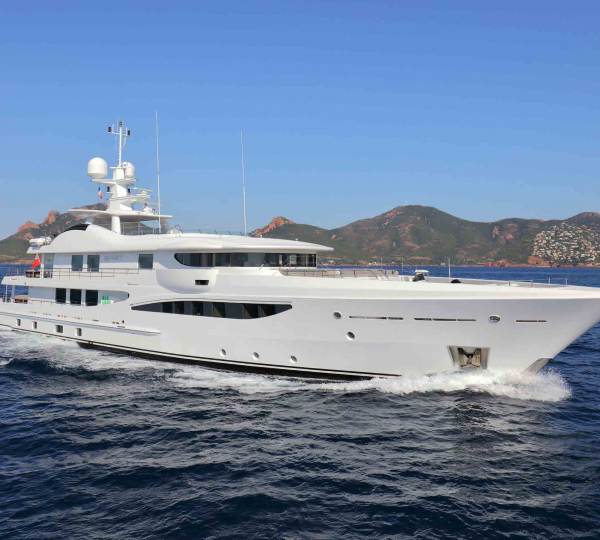
Windward Islands
Spirit news.
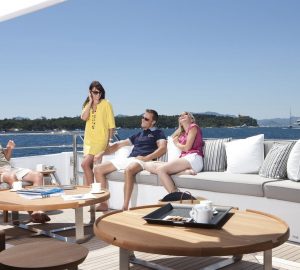
Highly recommended by charter brokers: ...
Similar yachts.
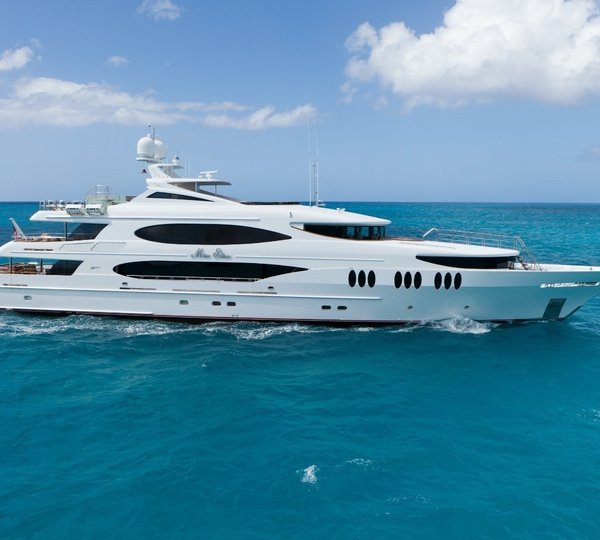
IMPROMPTU | From EUR€ 255,000/wk
- Yachts >
- Charter Yachts >
- Motor Yachts Over 100ft/30m for Charter >
SPIRIT Amels | From EUR€ 255,000 /wk
Launched in 2011, motor yacht SPIRIT is a 54.30-metre displacement Amels Limited Editions 177, built by the prestigious shipyard Amels in Vlissingen (Holland). Superyacht Spirit features naval architecture by Amels themselves and exterior design by Tim Heywood. Her light and contemporary interior is by Nuvolari Lenard, offering comfortable accommodation to up to 11 guests.
NOTABLE FEATURES: ~ Designed by Tim Heywood & features interior design by Nuvolari Lenard ~ Sundeck ~ Teppanyaki ~ Granite bar ~ Jacuzzi ~ Ample exterior living spaces ~ Gym ~ Spa centre ~ Magnificient maste suite with lavish facilities ~ Safe boat ~ State-of-the-art A/V enetrtainmnet system ~ Various water toys ~ Perfect for holding special events & parties
Special features include a fantastic massage and beauty therapy room along with a masseuse and a yoga instructor; as well as a gym located on the deck with great views to enjoy while working out. The sky lounge also features a 65-inch plasma TV.
VIDEO OF SUPERYACHT SPIRIT
Boasting the spacious sun deck, a perfect entertaining space for up to 100 guests can be found on the top deck, providing the professional teppanyaki grill. There is also the custom hot tub located on the bow as well as the epicurean style galley.
SPIRIT has been customised to the highest levels, and her interior can be described as light and contemporary in style with plentiful natural light entering through large windows. All cabinetry is in solid maple and oak. She also boasts a very vast sun deck and all her AV/TV systems are iPad driven.
SPIRIT Specifications
| Type/Year: | Amels/2011 |
|---|---|
| Refit: | |
| Beam: | 9.00m (29' 6") |
| L.O.A.: | 54.30 m (178'15'') |
| Crew: | 13 |
| Guests: | 11 |
|---|---|
| Max Speed: | 15.5 knots |
| Cabins: | 5 |
| Engines: | 2 x MTU 2100HP Engines V1 |
| Cruise Speed: | 12 knots |
| More Yacht Info: | , , , , , , |
|---|---|
| Builder/Designer: | , , |
| Locations: | , , , , , , , , , , , , , , , , , , , , , , , , , , , , , , , , , , , , , , |
54.3m superyacht Spirit is equipped with a spectacular selection of Sea Doo’s, mopeds, windsurfers, canoes as well as tenders.
With state of the art AV systems throughout, Amels yacht SPIRIT has a steel hull with an aluminium superstructure and has a beam measuring 9 metres (29'53''). Her cruise speed is 13 knots.
Yacht Charter Accommodation
Spirit features a light and contemporary interior by Nuvolari Lenard, offering luxurious accommodation to up to 11 guests. Guests will find comfort in one master suite, two VIP cabins, one double and one twin cabin. The sixth cabin has been converted into a dedicated spa area.
Charter Amenities and Extras
12m (40') CHASEBOAT! Safeboat Tender AKA THE BEAST 14 pax, fully custom, full cabin-inboard, diesel jet boat 40kts! AC and self-mitigating, shock absorbing seats make any sea condition pleasant. Fishing out-riggers and chair, and dive benches… 1 x 6.75m MEYER, Open Guest Tender with Bimini, Single Stern-drive, 35kts. 1 x 6.2m PASCOE, RIB Open Rescue boat. Jet drive , 30kts 2 x YAMAHA VXR HP Waverunners. ~7m Freestyle Cruiser water slide from sundeck to water. ~2 x F5S SEABOBS, 4 x Paddle Boards , 4 x KAYAKS, 4 in 1 multisport kayak kit ~Selection of windsurfers, selection of towable toys, ~1 x Large Inflatable SeaWater Trampoline ~Fishing gear. 6 x Rods & Reels with various tackle. ~DIVE GEAR: 2 x Dive compressors, 12 x 12L Steel dive tanks ,8 x octopus/regulators ~Dive gear is for rendezvous diving only. **Users must be qualified. ~Beach Set up , BBQ and Beach Volleyball ~X Box 360 and 2 x Controllers ~Play Station 2 and 3
Charter Yacht Disclaimer
This document is not contractual. The yacht charters and their particulars displayed in the results above are displayed in good faith and whilst believed to be correct are not guaranteed. CharterWorld Limited does not warrant or assume any legal liability or responsibility for the accuracy, completeness, or usefulness of any information and/or images displayed. All information is subject to change without notice and is without warrantee. A professional CharterWorld yacht charter consultant will discuss each charter during your charter selection process. Starting prices are shown in a range of currencies for a one-week charter, unless otherwise marked. Exact pricing and other details will be confirmed on the particular charter contract. Just follow the "reserve this yacht charter" link for your chosen yacht charter or contact us and someone from the CharterWorld team will be in touch shortly.
SPIRIT Enquiry
“There’s the pleasure derived from beauty - beautiful things alone can save us. There’s no explicit functionality which can show the way to project design related decision making. What moves everything is passion for beauty. This is the sexiest thing about the boat taken as an object which really makes it very different to houses, paintings, or other forms of art. The chance to put your boat object you have fallen in love with on show for all to see. It’s a near perverted aspect of wanting to share your very own passion with someone else. Boats can be shown off anywhere. And moreover you sleep inside her, you cruise in beautiful places with her and having style you probably enjoy better interiors than you have at home. " - Dan Lenard from Nuvolari – Lenard, a large, multi-award winning Italian yacht design firm.
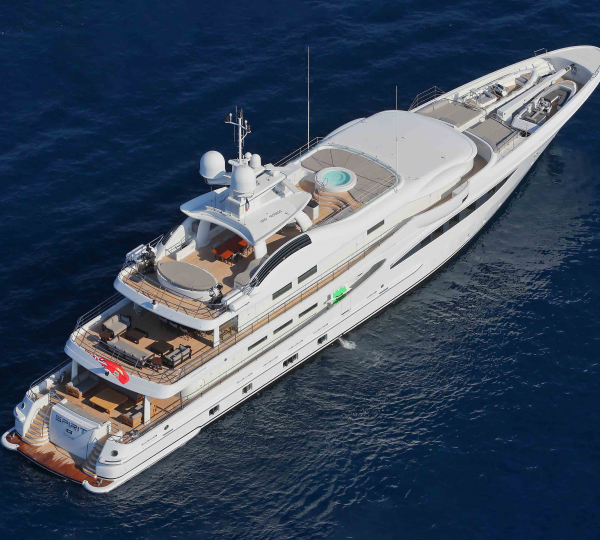
REVERIE | From US$ 255,000/wk
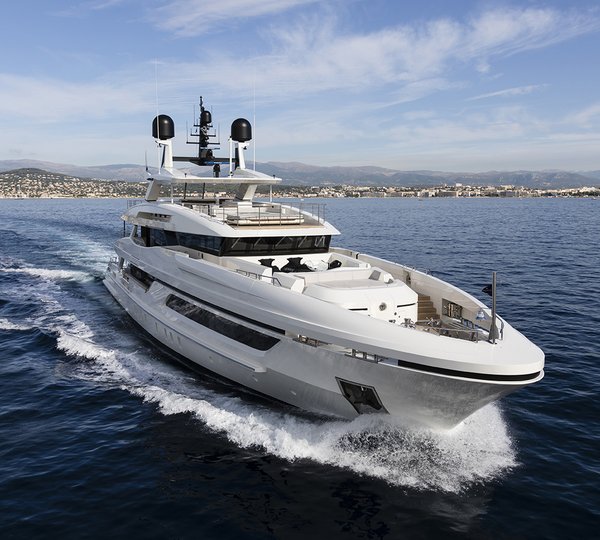
ANDIAMO | From EUR€ 255,000/wk
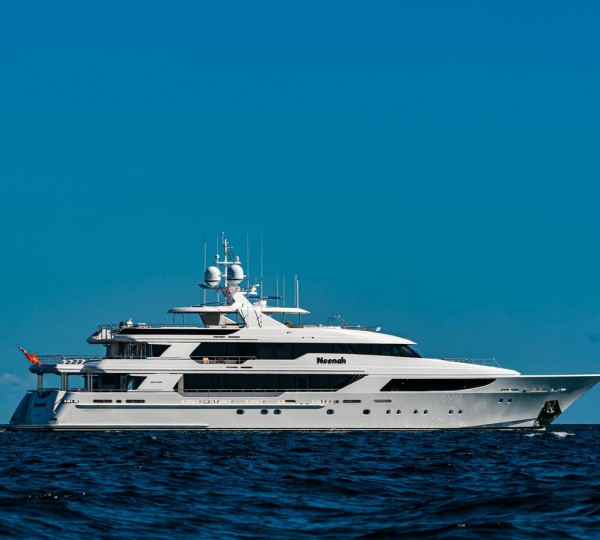
NEENAH | From US$ 255,000/wk
- News & Trends
- Luxury yachts
- Offshore motor yacht
- Spirit Yachts
Exhibitions
Classic motor yacht p70 cruising expedition offshore.

Characteristics
21.7 m (71'02" )
5 m (16'04" )
1.7 m (5'06" )
24 t (26.5 us ton)
10,000 l (2,642 gal)
1,200 l (317 gal)
Description

Meet this supplier at the following exhibition(s):
25-27 Jul 2024 Camden (USA - Maine)
1-04 Aug 2024 Sydney (Australia)
Other Spirit Yachts products
The power portfolio.

- Luxury yacht
- Luxury motor-yacht
- Displacement hull yacht
- Cruising motor yacht
- Flybridge yacht
- Flybridge motor yacht
- 4-cabin motor yacht
- Displacement motor yacht
- Wheelhouse motor yacht
- High-speed motor yacht
- Explorer motor yacht
- Sailing super-yacht
- Cruising sailing super-yacht
- Traditional motor yacht
- Propeller shaft motor yacht
- Sloop sailing super-yacht
- Semi-custom motor yacht
- Expedition motor yacht
- 7-berth motor yacht

- United Kingdom
- New Cut East IP3 0EA Spirit Yachts Ltd
company History
the Most known Builder of wooden, or >classic, the boatbuilding industry was founded by designer and sailor Sean McMillan in 1993. It was his second attempt to do business. A year earlier, the Bank withdrew the entire startup McMillan Yachts , and along with housing Sean.
In the room of the old farm in Suffolk Sean and his partner Mick Newman made the first Spirit 37 . She impressed the connoisseurs of elegance and speed.
the Founders of Spirit Yachts were inspired by the classic boat 1930 , with the use of modern technologies of wood processing and forming blocks.
Even with orders, Macmillan and Nyman never left the farm, while their life is not forced. In 2003, Spirit Yachts has started to build 70 ft , which just did not fit in the old hangar. According to another version, the police asked the workers to find another place noise. The new building of the shipyard was the Old Wet Dock in the centre Ipswich .
worldwide fame with Spirit Yachts have received with the release of the 2006 film "Casino Royale "where James bond walked on the Grand canal Venice the elegant Spirit 54 . After filming, the boat was immediately sold, and Spirit Yachts was able to prove that classic never goes out of fashion.
In 2007, Spirit Yachts have built the first fully wooden 100 ft boat Gaia. The yacht was so beautiful and fast that it is now laid her increased 111-foot version.
company Status
the Crisis of 2008 was a test for Spirit Yachts. But the company managed to survive and even to get a British award for achievements in entrepreneurship.
Manufacturing
the Shipyard Spirit Yachts is Ipswich Haven Marina . The area of the yard is 1500 sq m. the production employs about 60 people.
exclusive Spirit Yachts builds sailing yachts from 11 to 30 m in length, entirely of wood. Model range divided into line Classic, Deckhouse and Cruising. Are separately superyacht Spirit of 100 or more feet. Every boat, and all of them built more than 60, is a work of art, with a corresponding cost.
Motorboats Spirit are the object of reverence of fans. Boats Spirit even more rare than sailboats, therefore, the secondary market for them is a real hunt. Exclusive offer from Spirit Yachts can be considered their projects to The Royale and Spirit P70 — motor yacht of the highest quality.
In 2018, Spirit Yachts celebrated 25th anniversary victories in regattas and the laying of the first sailing boats with a hybrid power plant. Yacht Spirit 111 >has a 4-BMWi batteries that are charged while driving under the sails.
the Name of wood, which are made of body, Spirit Yachts, sound like music. It is Oregon pine, Sapele, cylindrical, Cuban mahogany, natkanski cypress. The interior is used teak. Boat work light and fast, for example, Spirit 46 speeds up to 20 knots.
a Passionate yachtsman Sean McMillan believes sailing race Yachts the philosophy of Spirit, and therefore his own Spirit 52' Flight of Ufford is constantly on the start of the next "classic" regatta. Here, McMillan draws inspiration and ideas for projects, because Spirit Yachts are not attracted to third-party designers.
Yacht models

Discontinued production models
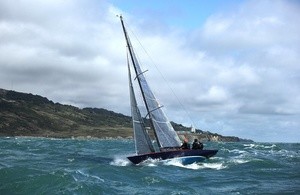
- Advertising
Customer reviews

- Netherlands
- United States
Asking Price
€25,900,000
Summer Charter
Winter Charter
Effortless Afloat
More beach house than floating palace; to stay on board is to feel infinitely connected to the ocean, yet completely at home. Spirit shares the characteristically fluid deck spaces and stretched out sun deck of the Amels Limited Editions models. Sun lovers can rejoice with a choice of outdoor social spaces across her three decks, with her sun deck offering the choice between formal dining for 14 to a more relaxed teppanyaki grill set up for more intimate entertaining.
Not for sale or charter to U.S. residents while in U.S. waters
CHARTER LOCATION
Summer: Mediterranean, West Mediterranean, East Mediterranean
Winter: Caribbean, Bahamas
Standout Features
This is Spirit
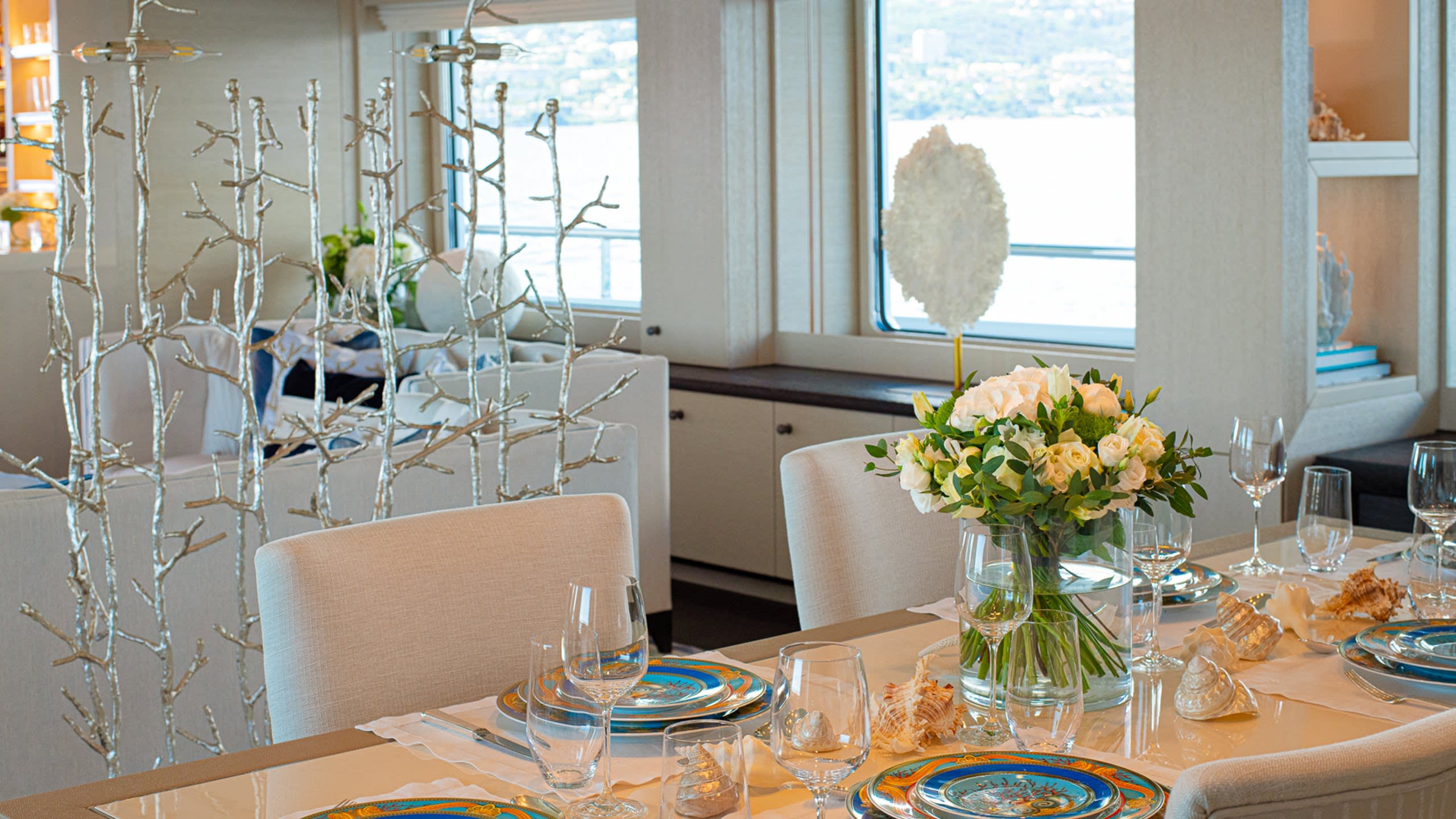
Stunning Interior Design
Echoes of the ocean.
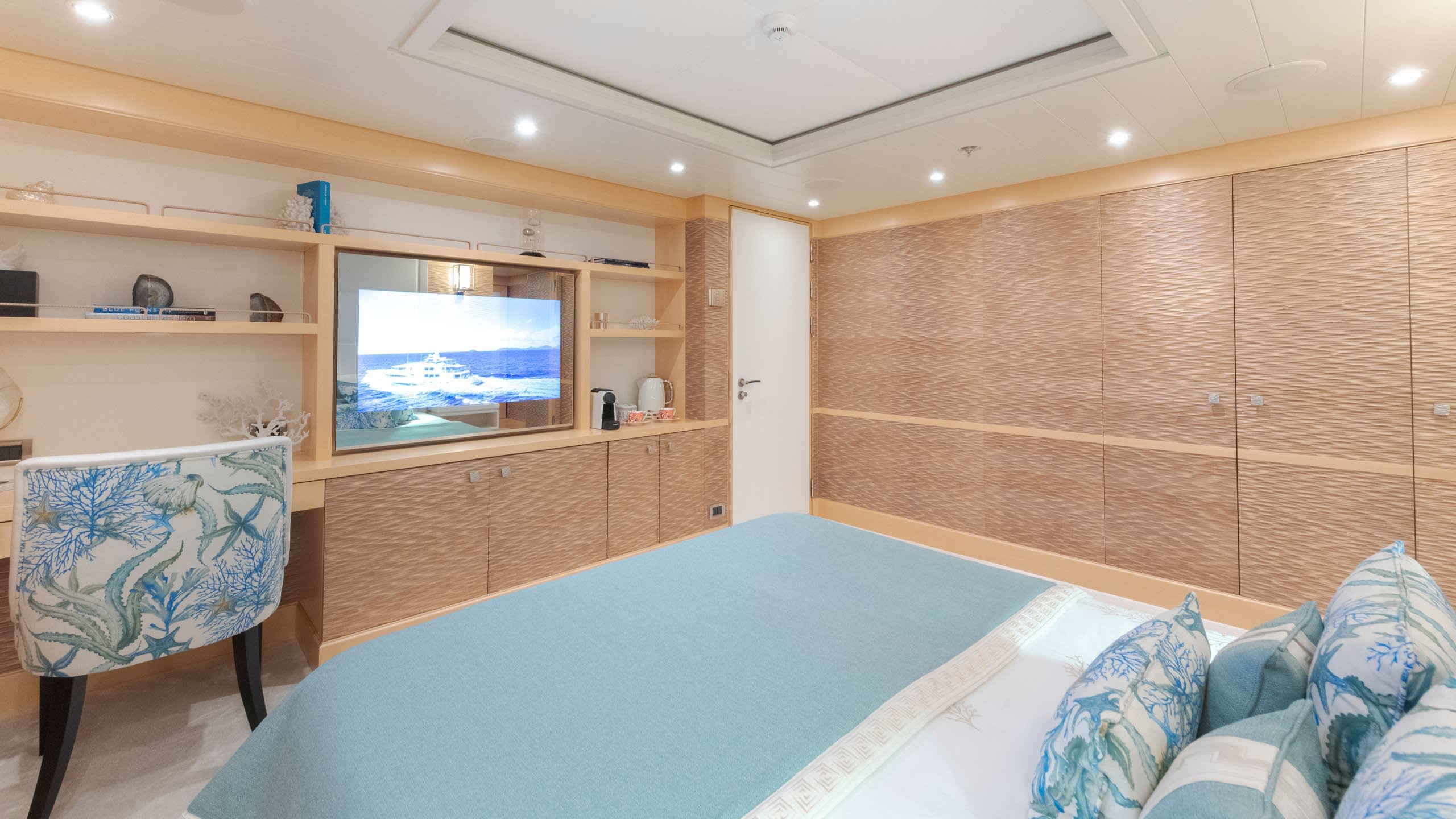

Spacious Accommodation
For up to 11 guests.
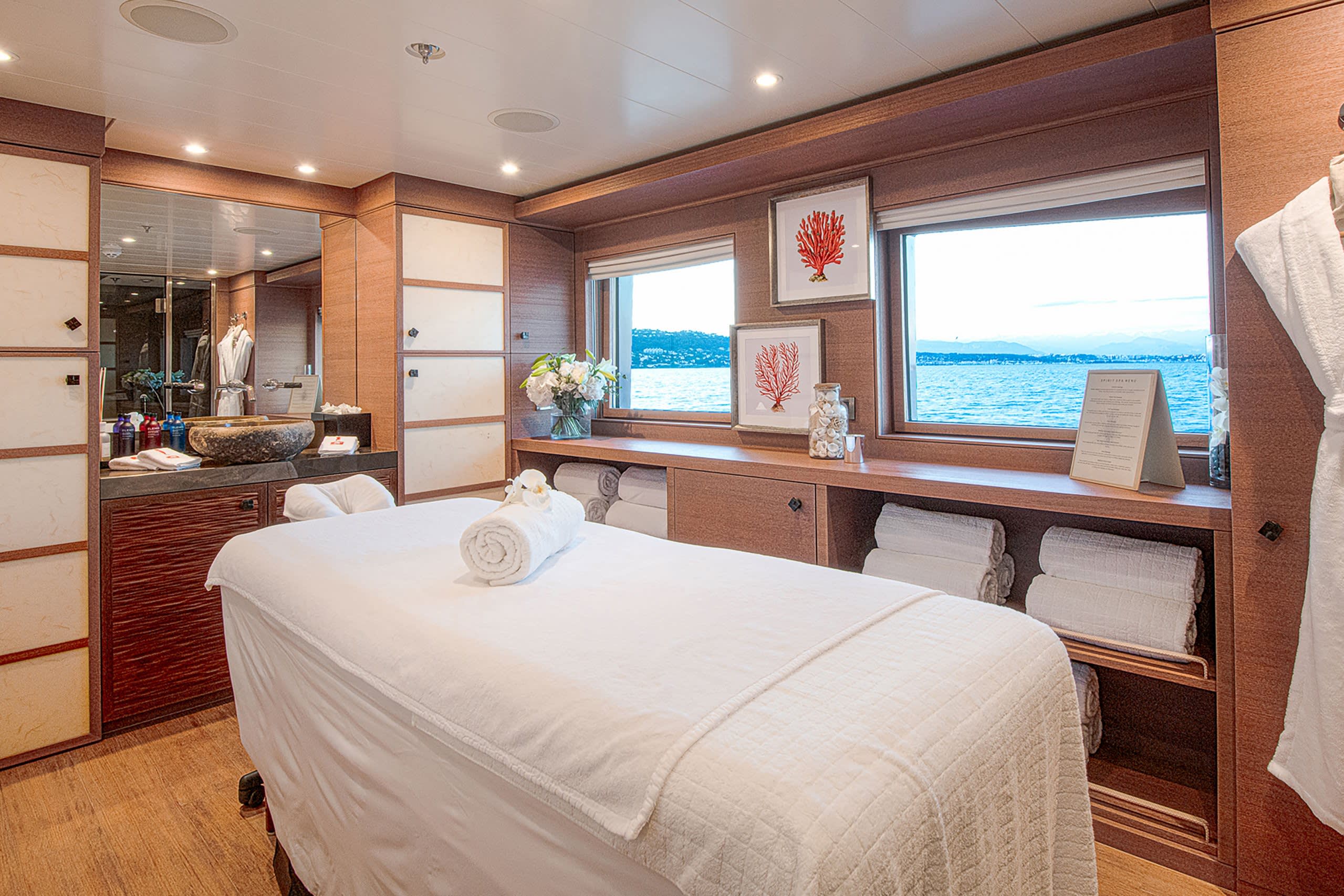
Onboard Wellness
Massage room with hammam and ELEMIS treatments.

Spacious Sun Deck
Sun worshippers enjoy foredeck pads or spacious sun deck
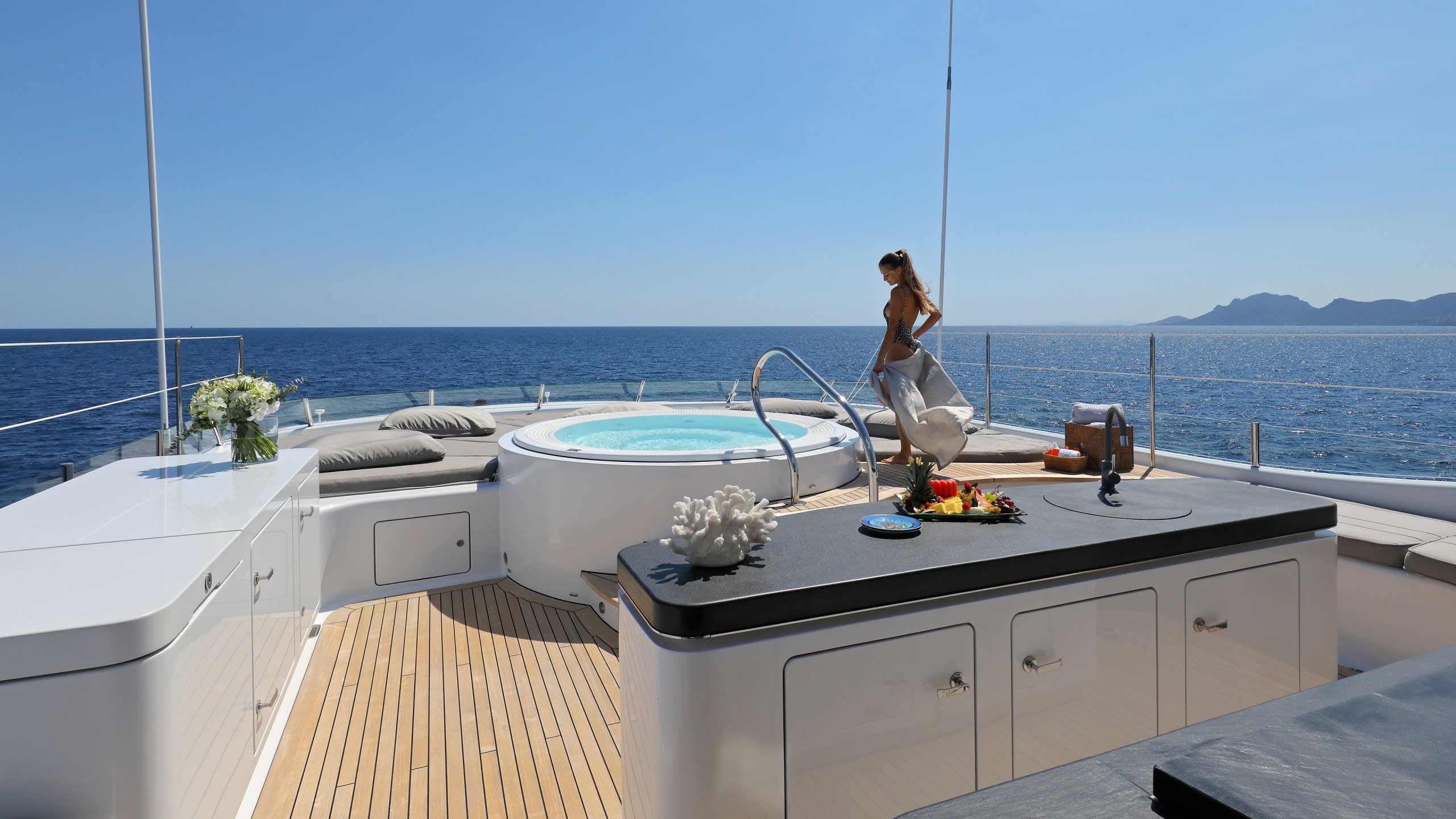
Surrounded by large sunpads.
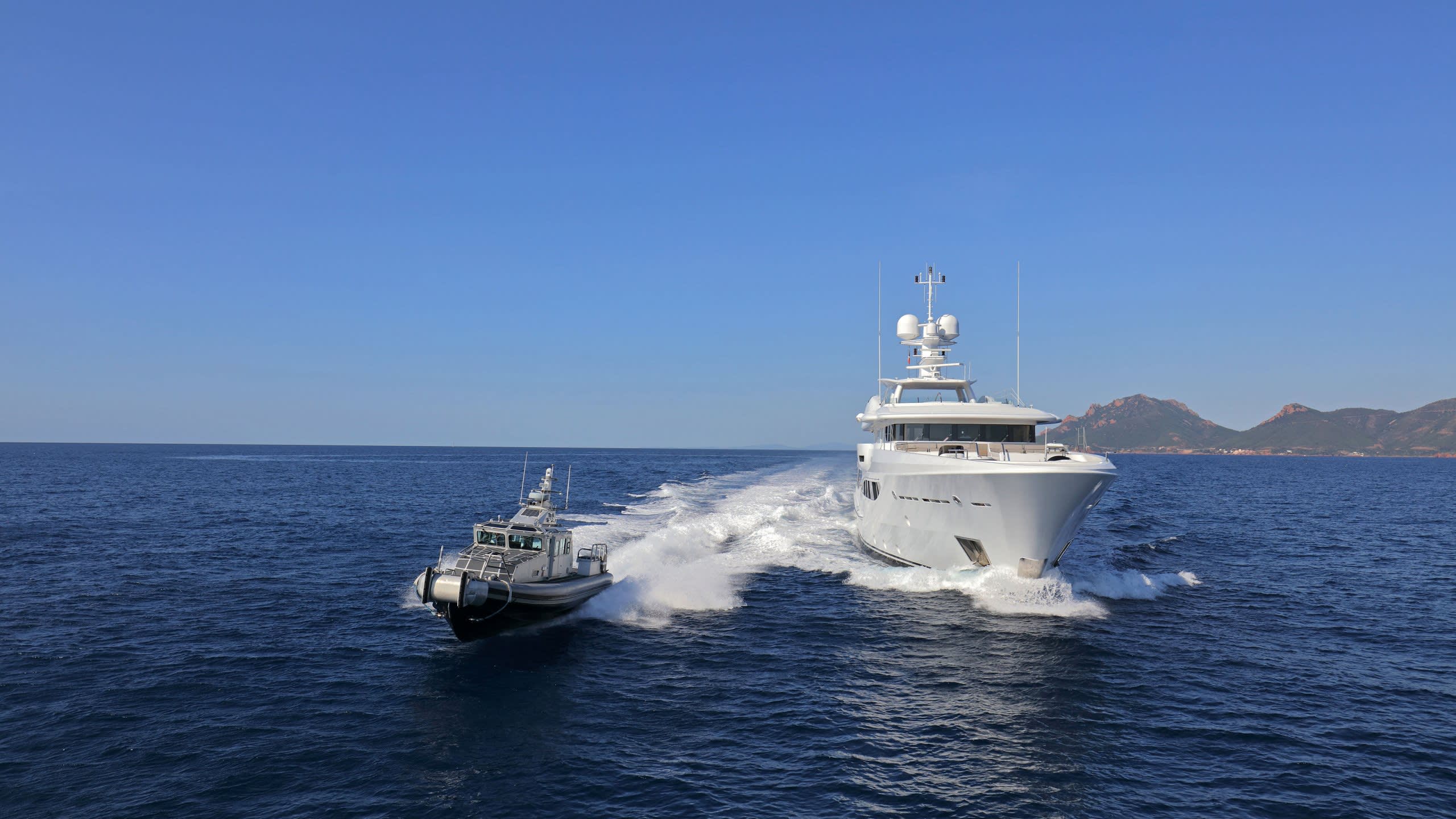
High-Speed Tender
12m custom tender, 'The Beast,' is ideal for trips ashore.
Yacht Video
Take a tour on board.
Media Gallery
Spirit Through the Lens
The Spirit of The Sea
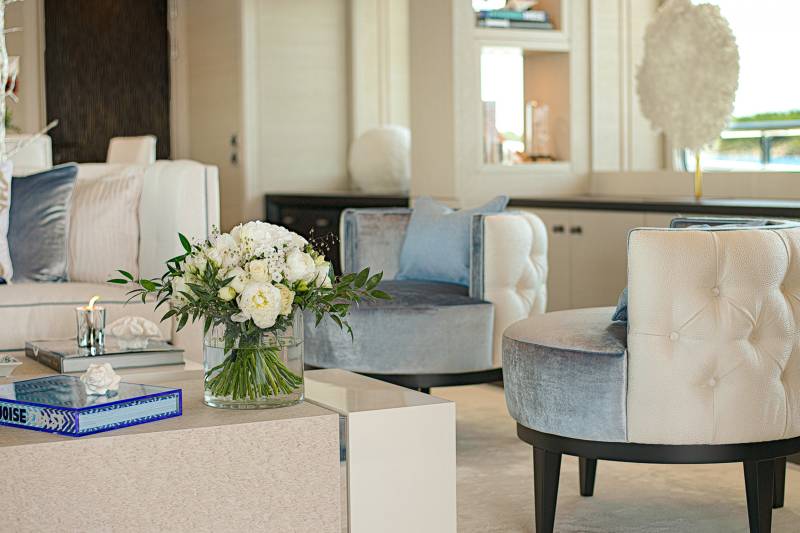
Breezy Ocean Style
Spirit’s interior embraces the spirit of the sea. Sunlight pours through picture windows onto bright, light spaces, while calming neutral hues are livened by colourful touches and delicate finishes, with deliciously tactile materials that echo the textures and colours of the ocean.
Effortless Entertaining
Spirit’s main deck salon and dining area offers a bar, large sofas and dining for 10, while an additional upper deck salon offers another bar, additional soft seating and an 85-inch plasma screen TV.
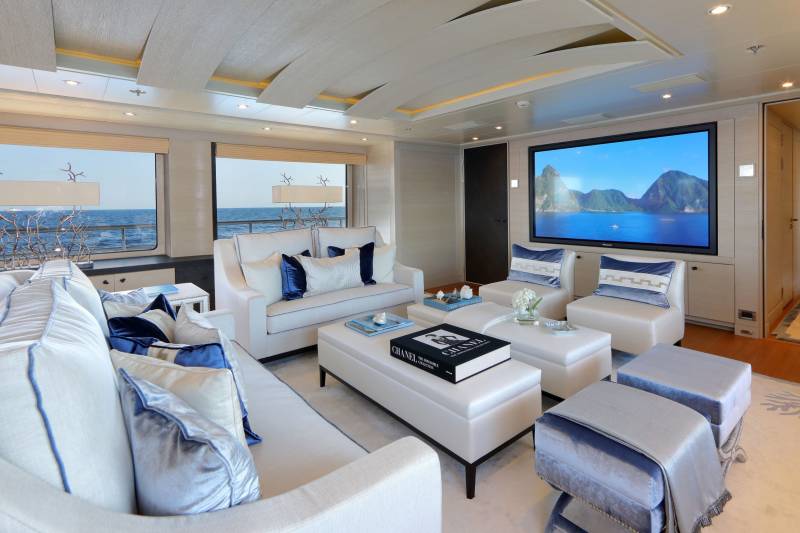
Massage Treatment Room
Onboard wellness is catered for with a main deck massage treatment room with hammam, with ELEMIS skin care treatments as well as massage therapy provided by Spirit’s onboard spa therapist.
Sea Spirited
Sun lovers can rejoice with a choice of outdoor social spaces across Spirit's three decks. The main deck aft offers casual seating and access to the swim platform, while above, the heated upper deck aft space provides dining for 10 guests.
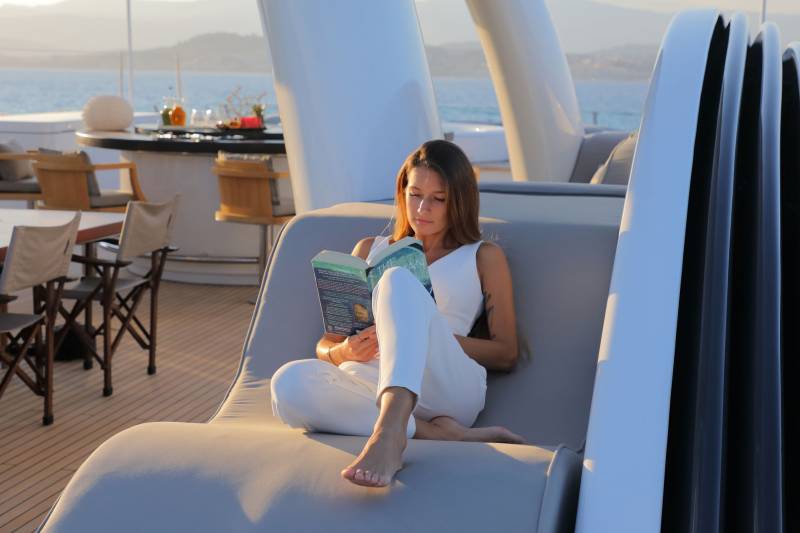
Stellar Sun Deck
Spirit’s vast sun deck is set up for everything from casual lounging around the Jacuzzi to more formal entertaining, with dining for more than 12 guests, a granite feature bar and a unique teppanyaki grill.
Al Fresco Dining
Dining can be accommodated on the heated upper deck aft or the sun deck, both of which have tables to seat the entire complement of guests. The teppanyaki grill on the sun deck is the perfect setting for an informal lunch or dinner under the sun or stars.
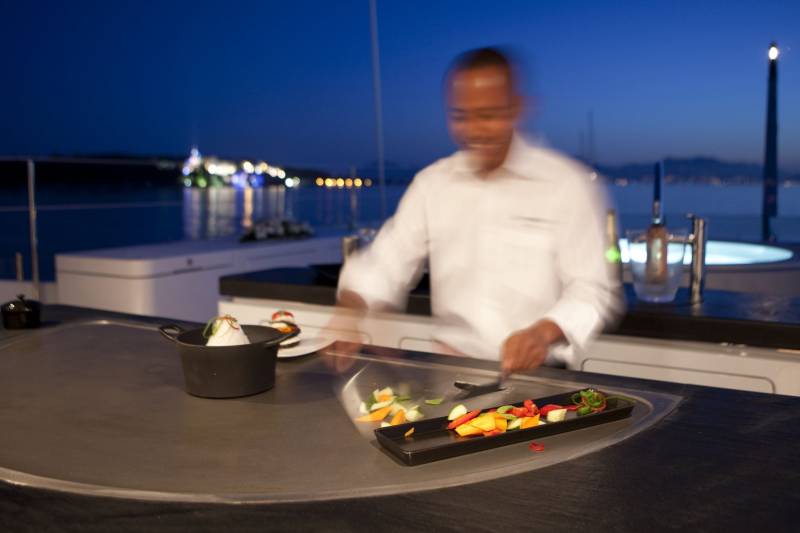
Accommodation
An Oasis of Calm

Luxurious Suites
Spirit accommodates up to 11 guests in 5 cabins, including a main deck master suite with and four additional cabins on the lower deck – three with king size beds and a twin cabin with additional Pullman. Each stateroom has touch screen controls for all room functions including entertainment, lighting, temperature, blinds and shades. Hermes and La Prairie products in every cabin complete the luxurious charter experience.
Cabin Arrangement

Principal Cabin
Emperor-sized bed, lounge, office, ensuite and walk-in dressing.

King Double Cabins
Lower deck: Three king-size suites, cathedral oak, plasma, touchscreen controls.
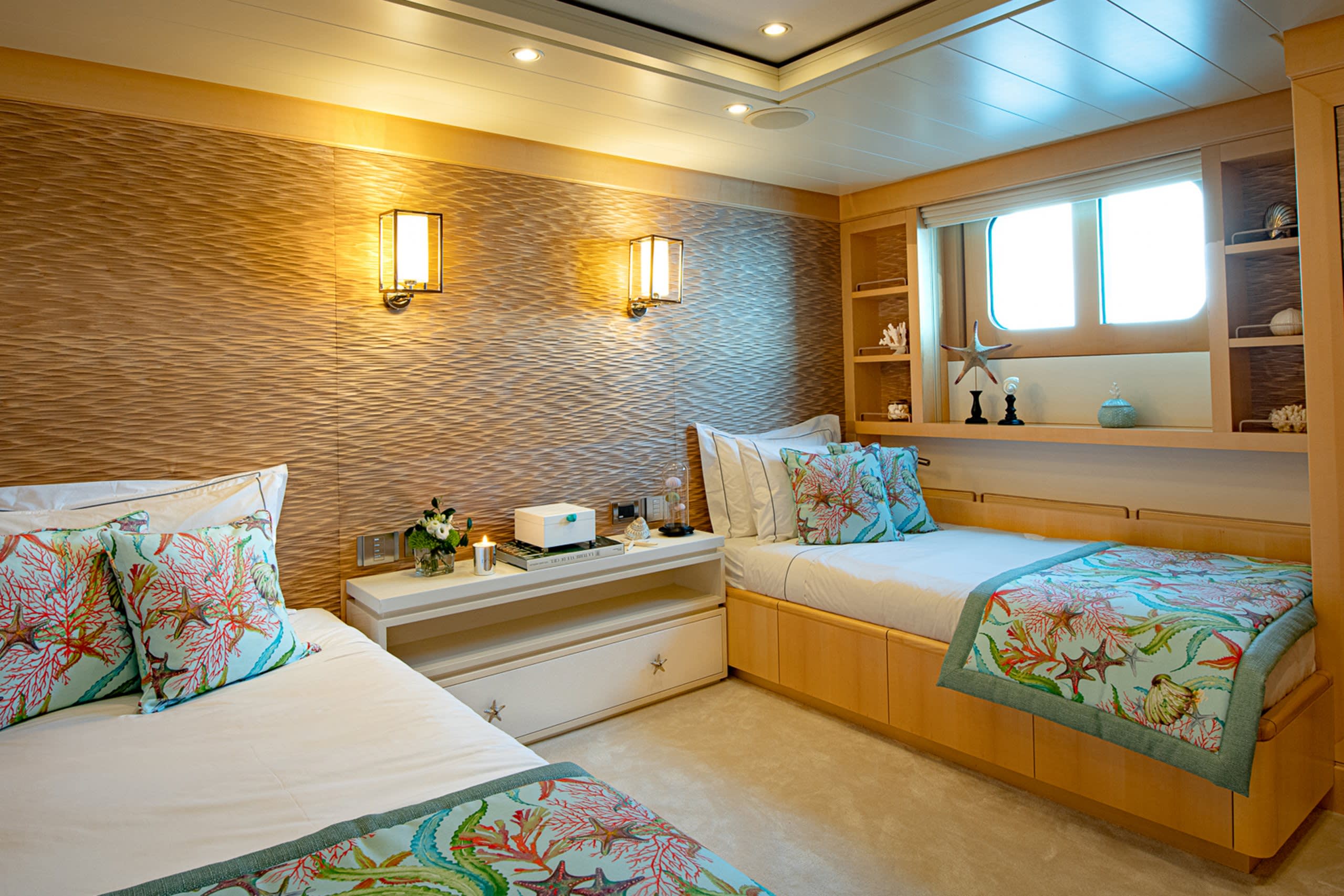
Also on the lower deck with added Pullman if needed.
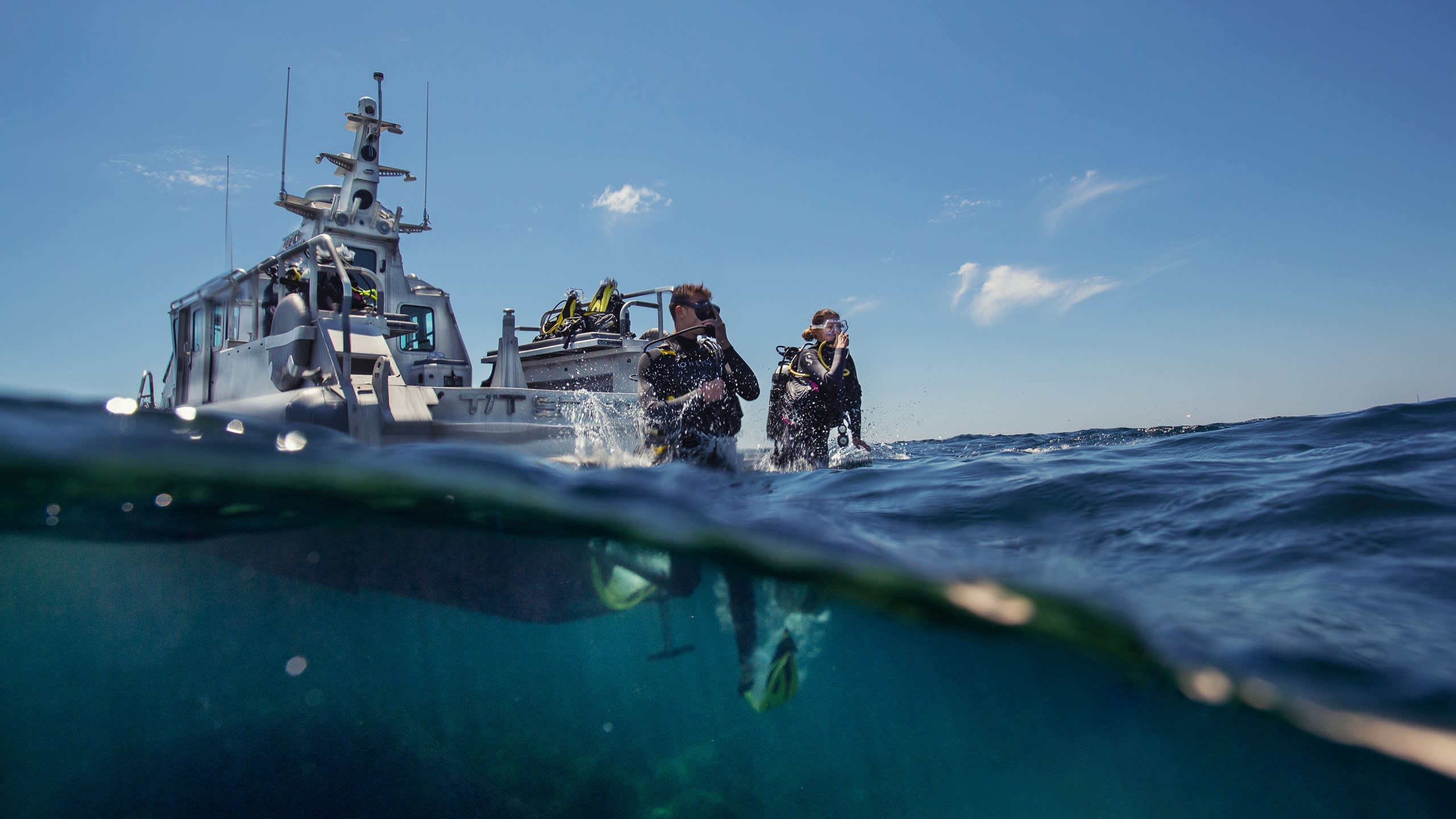
More Toys Than Most
What's in the Toybox
2 x Jet Skis 4 x Kayaks 1 x Slide 3 x Towable Toys 2 x Seabobs 1 x Windsurf 1 x Floating Trampoline 3 x Tenders 4 x Stand Up Paddle Boards 10 x Diving Equipment 6 x Fishing Equipment
Please note that the tenders and toys on board the yachts are regularly updated. Please contact Y.CO for the most up to date list.
Toys Galore
Spirit’s inventory of toys is one of the most extensive collections on the water, and includes everything from diving equipment to jetskis, sailing dinghies to inflatables and everything in between.
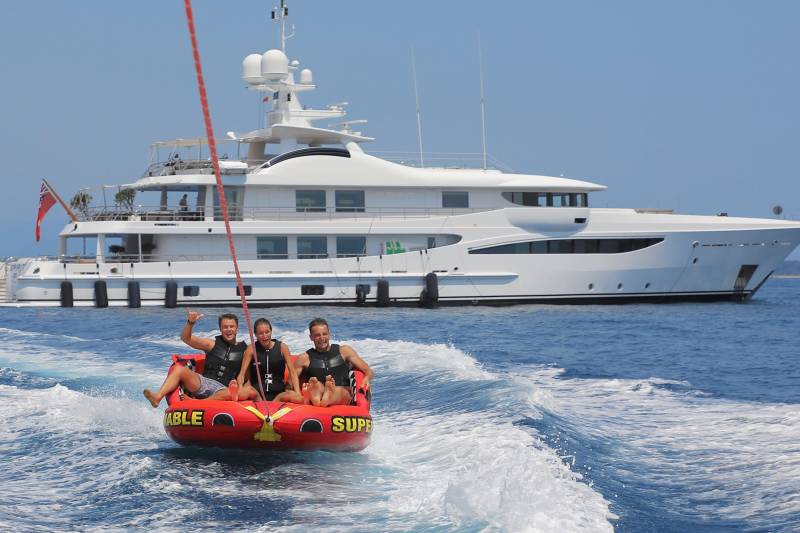
Spirit’s 12m fully-custom safeboat tender, affectionately known as The Beast, can shuttle up to 14 guests ashore at speeds of up to 40 knots in absolute comfort.
Charter Spirit in the Caribbean and Bahamas

From East to West
St Vincent to Grenada. Discover your own desert island adventure. With 32 islands to choose from, it's an excuse to return again and again.

Breathtaking Ocean Vistas
English Harbour to Fallmouth Harbour. Cruise around Antigua and Barbuda. Imagine turquoise waters and sugary white sand beaches.
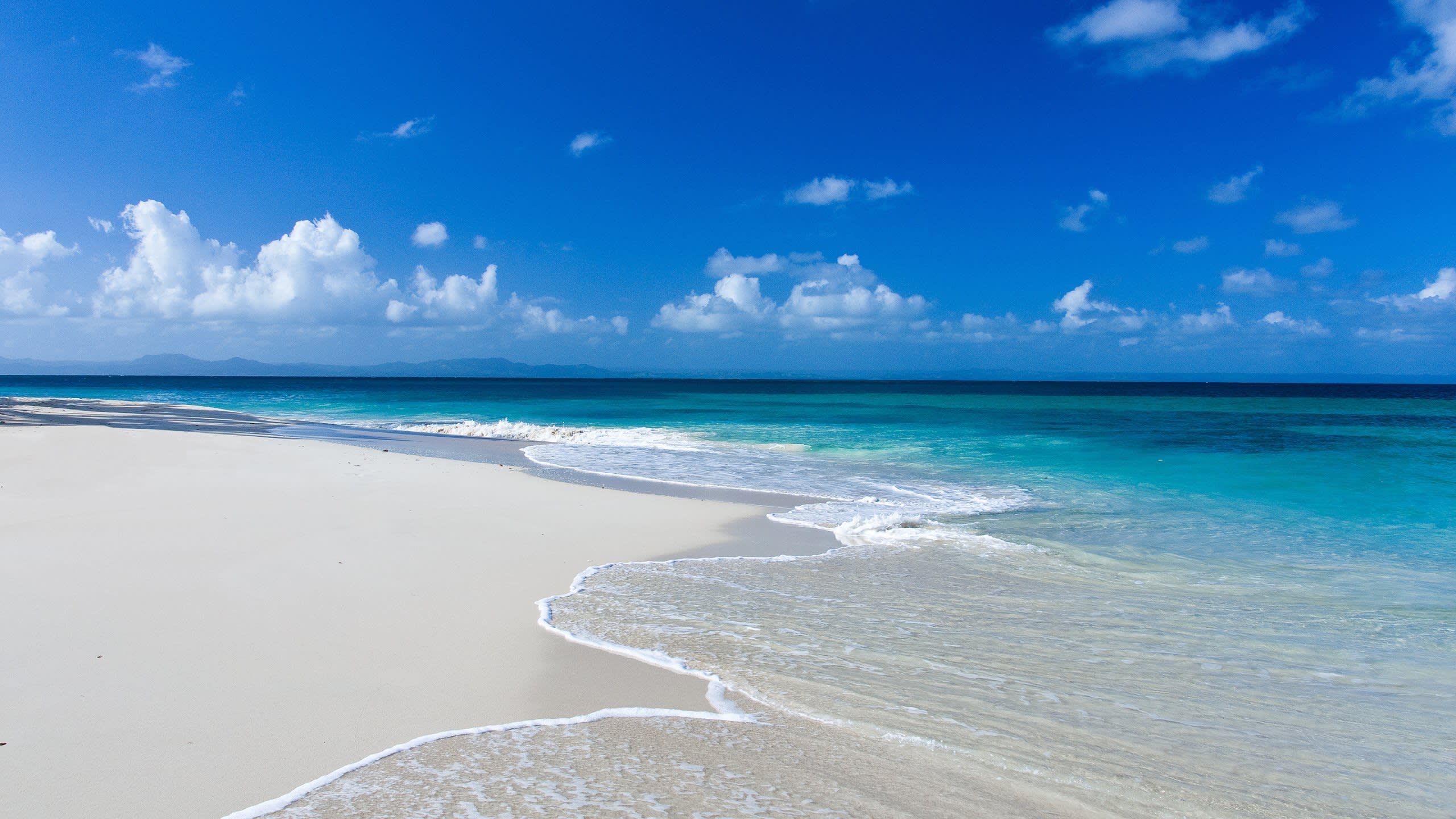
Bahamas Outer Island Cruising Guide
Fishing and exploring the Bahamian Outer Islands
Charter Spirit in the Med
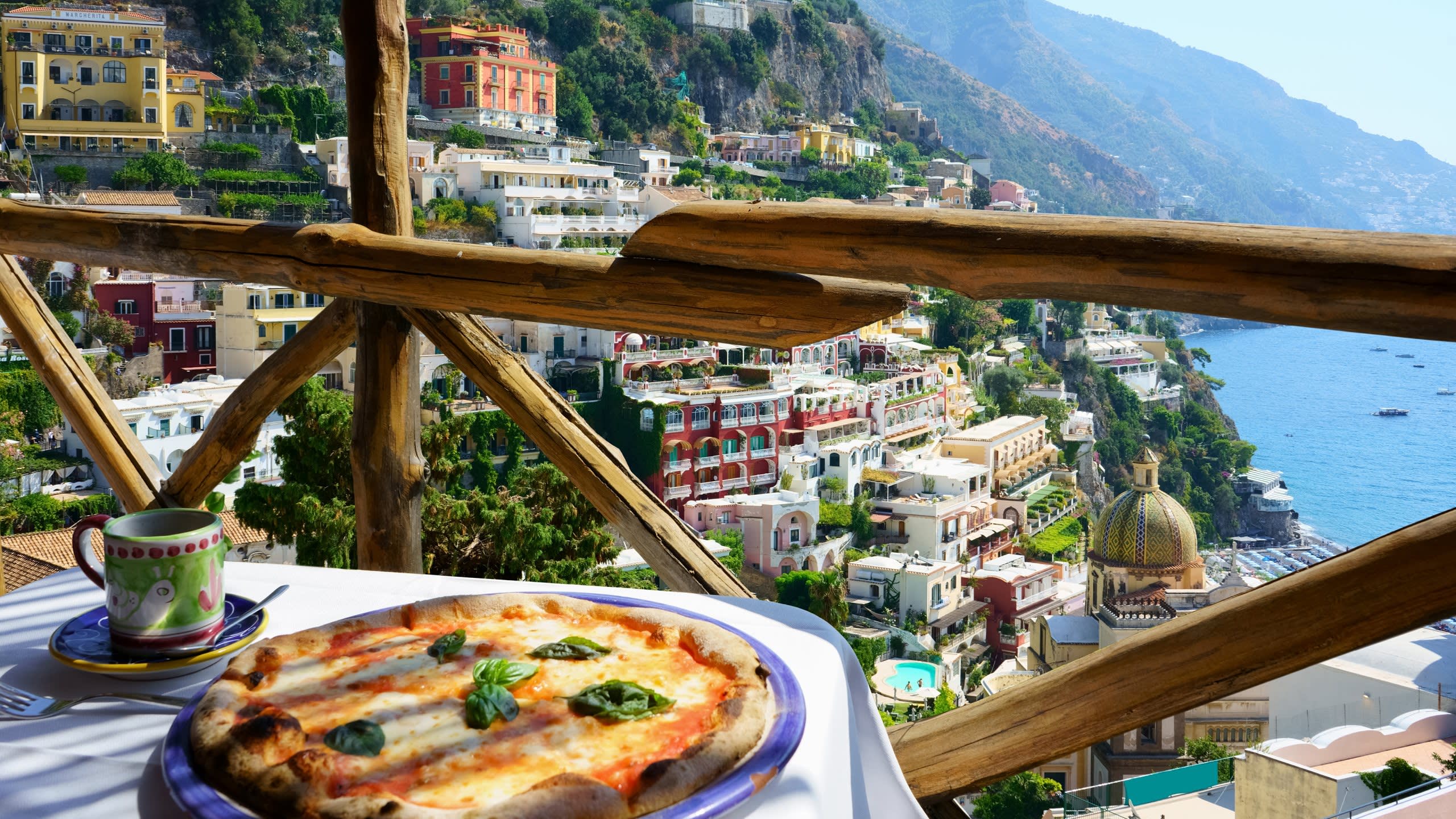
Italia Deliziosa
Naples to Palermo. Travel around Italy’s top two culinary coastlines, in the company of food guides, Michelin stars and your own personal chef.

Greece Gone Wild
Skopolos to Koupanaries Beach. Cruise through Greece’s wildest archipelago. Private island picnics, seabob safaris and hundreds of deserted beaches.
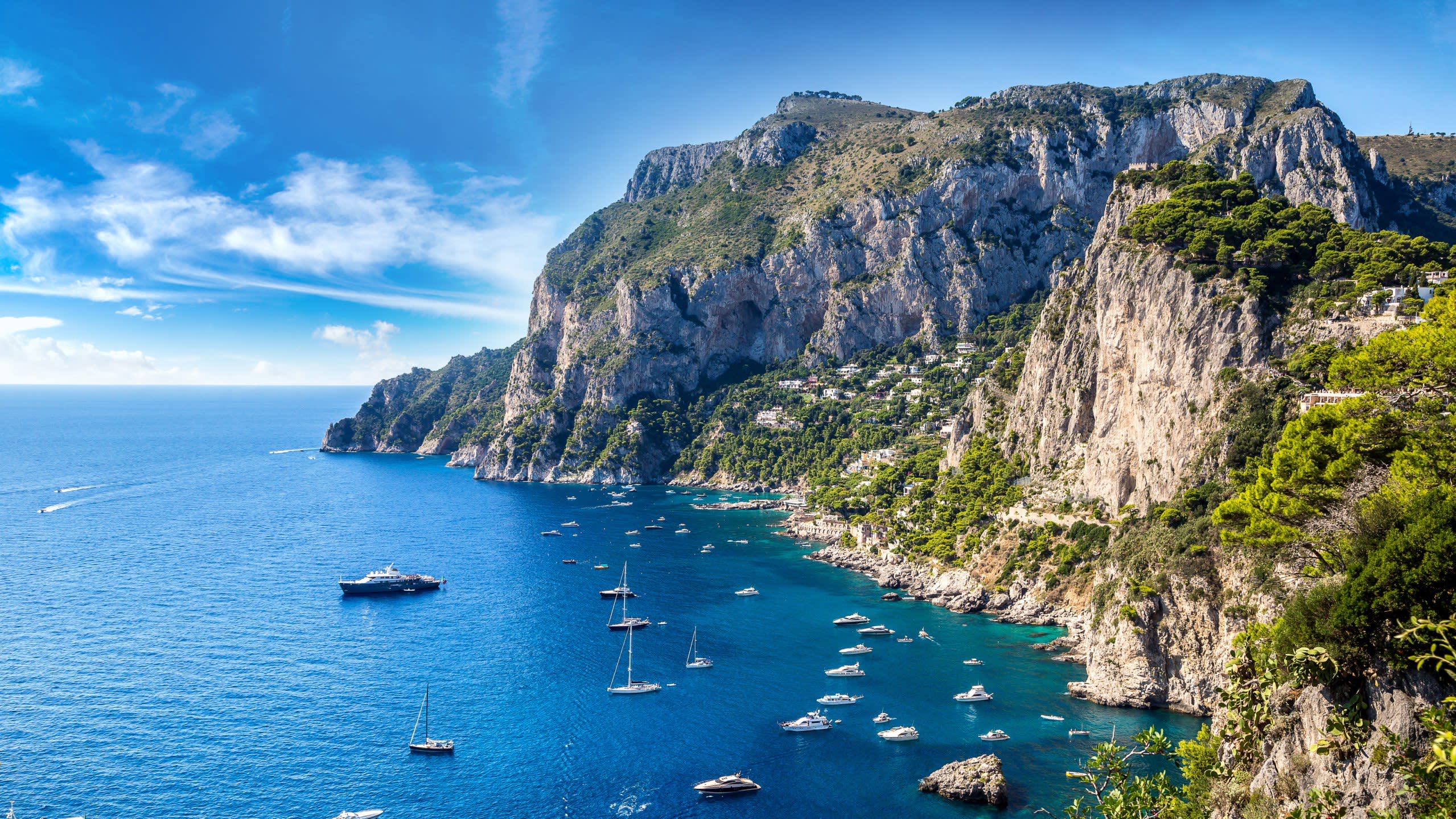
Unmissable Amalfi
Naples to Naples. The Amalfi Coast is Superyacht heaven and for good reason. Hidden coves, secluded beaches and a nightlife to suit all occasions.

Yachting's Favourite Playground
Monaco to Nice. Cruising the French Riviera is not a once in a lifetime experience. It's an annual, unmissable event.
More Yachts like Spirit
Hospitality
Your privacy.
We use cookies to enhance your browsing experience, analyse our traffic and assist in personalised marketing. By selecting “Allow Cookies”, you consent to our use of cookies.
LET'S CHAT.
Get in touch with one of our teams around the world.
Where you'll find us
Monaco — MC
London — UK
Fort Lauderdale — US
Auckland — NZ
Please use a modern browser to view this website. Some elements might not work as expected when using Internet Explorer.
- Landing Page
- Luxury Yacht Vacation Types
- Corporate Yacht Charter
- Tailor Made Vacations
- Luxury Exploration Vacations
- View All 3684
- Motor Yachts
- Sailing Yachts
- Classic Yachts
- Catamaran Yachts
- Filter By Destination
- More Filters
- Latest Reviews
- Charter Special Offers
- Destination Guides
- Inspiration & Features
- Mediterranean Charter Yachts
- France Charter Yachts
- Italy Charter Yachts
- Croatia Charter Yachts
- Greece Charter Yachts
- Turkey Charter Yachts
- Bahamas Charter Yachts
- Caribbean Charter Yachts
- Australia Charter Yachts
- Thailand Charter Yachts
- Dubai Charter Yachts
- Destination News
- New To Fleet
- Charter Fleet Updates
- Special Offers
- Industry News
- Yacht Shows
- Corporate Charter
- Finding a Yacht Broker
- Charter Preferences
- Questions & Answers
- Add my yacht
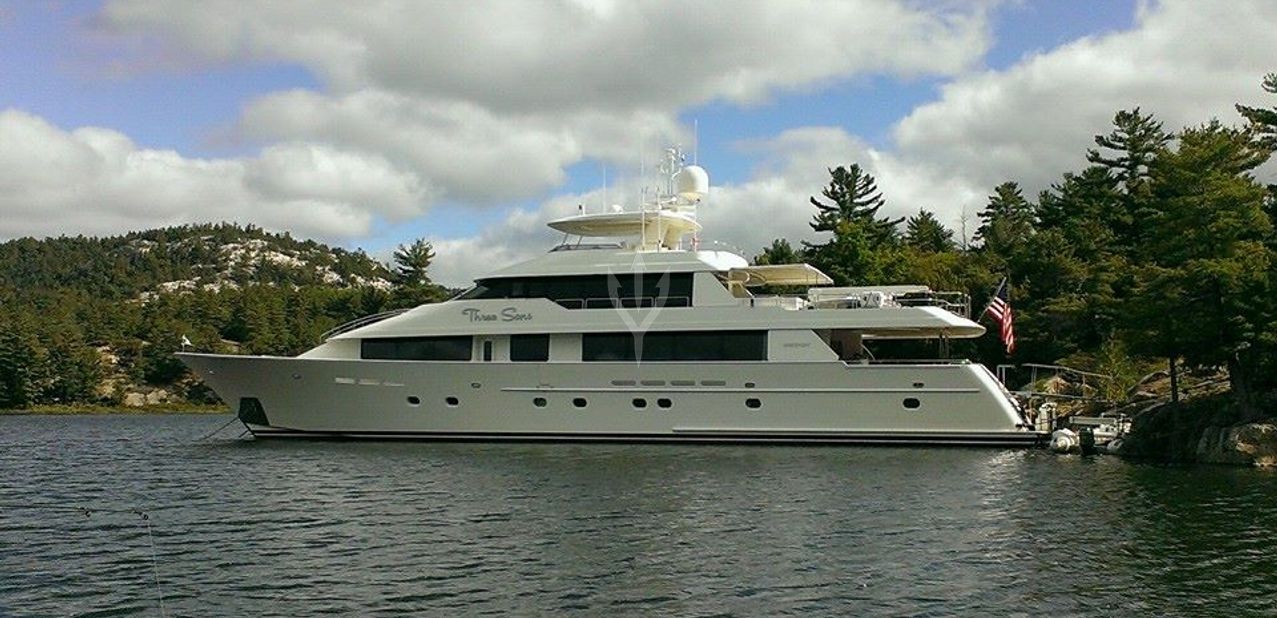
NOT FOR CHARTER *
This Yacht is not for Charter*
SIMILAR YACHTS FOR CHARTER
View Similar Yachts
Or View All luxury yachts for charter
- Luxury Charter Yachts
- Motor Yachts for Charter
Free Spirit
- Amenities & Toys
FREE SPIRIT yacht NOT for charter*
39.62m / 130' | westport yachts | 2007 / 2019.
Owner & Guests
Cabin Configuration
- Previous Yacht
Special Features:
- Interior design from Westport Yachts
- Cruising speed of 24 knots
- Sleeps 10 overnight
- Shallow draft and fast speeds for reef exploration
The 39.62m/130' motor yacht 'Free Spirit' (ex. Oras) was built by Westport Yachts in the United States at their Westport, WA shipyard. Her interior is styled by American designer design house Westport Yachts and she was completed in 2007. This luxury vessel's exterior design is the work of Gregory Marshall and she was last refitted in 2019.
Guest Accommodation
Free Spirit has been designed to comfortably accommodate up to 10 guests in 5 suites. She is also capable of carrying up to 8 crew onboard to ensure a relaxed luxury yacht experience.
Range & Performance
Built with a GRP hull and GRP superstructure, with teak decks, she benefits from a semi-displacement hull to provide exceptional seakeeping and impressive speeds. Powered by twin diesel MTU (12V 4000 M90) 12-cylinder 2,735hp engines, she comfortably cruises at 24 knots, reaches a maximum speed of 28 knots. Her low draft of 0.61m/2' makes her primed for accessing shallow areas and cruising close to the shorelines. Her water tanks store around 6,132 Litres of fresh water.
| Length | 39.62m / 130' |
| Beam | 2.41m / 7'11 |
| Draft | 0.61m / 2' |
| Gross Tonnage | 298 GT |
| Cruising Speed | 24 Knots |
| Built | | (Refitted) |
| Builder | Westport Yachts |
| Model | Westport 130 |
| Exterior Designer | Gregory Marshall |
| Interior Design | Westport Yachts |
*Charter Free Spirit Motor Yacht
Motor yacht Free Spirit is currently not believed to be available for private Charter. To view similar yachts for charter , or contact your Yacht Charter Broker for information about renting a luxury charter yacht.
Free Spirit Yacht Owner, Captain or marketing company
'Yacht Charter Fleet' is a free information service, if your yacht is available for charter please contact us with details and photos and we will update our records.
Free Spirit Photos
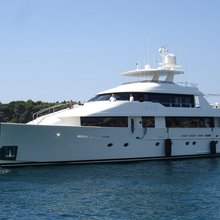
NOTE to U.S. Customs & Border Protection
Specification
M/Y Free Spirit
| Length | 39.62m / 130' |
| Builder | |
| Exterior Designer | Gregory Marshall |
| Interior Design | Westport Yachts |
| Built | Refit | 2007 | 2019 |
| Model | |
| Beam | 2.41m / 7'11 |
| Gross Tonnage | 298 GT |
| Draft | 0.61m / 2' |
| Cruising Speed | 24 Knots |
| Top Speed | 28 Knots |
SIMILAR LUXURY YACHTS FOR CHARTER
Here are a selection of superyachts which are similar to Free Spirit yacht which are believed to be available for charter. To view all similar luxury charter yachts click on the button below.
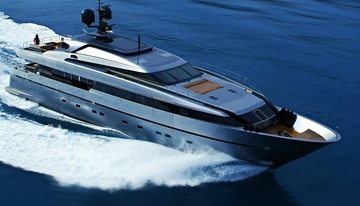
39m | Sanlorenzo
from $118,000 p/week ♦︎

40m | Sunseeker
from $150,000 p/week

42m | Urkmezler Yachts
from $150,000 p/week ♦︎
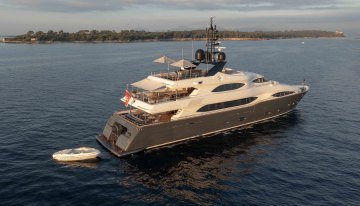
from $75,000 p/week
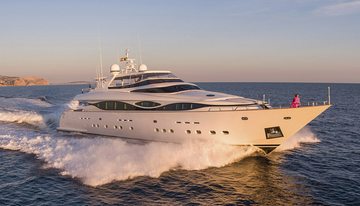
Always Believe
40m | Maiora
from $107,000 p/week ♦︎
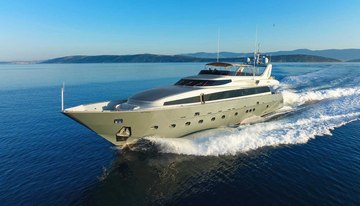
36m | Admiral Yachts
from $54,000 p/week ♦︎
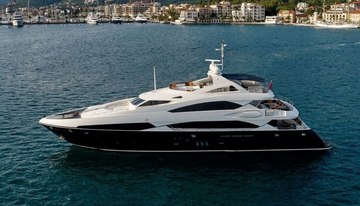
37m | Sunseeker
from $137,000 p/week ♦︎
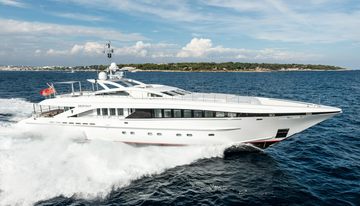
37m | Heesen
from $113,000 p/week ♦︎
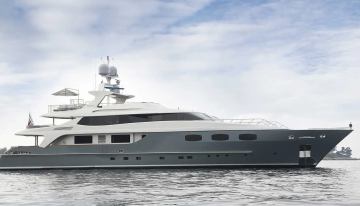
43m | Baglietto
from $134,000 p/week ♦︎

37m | Couach
from $91,000 p/week ♦︎
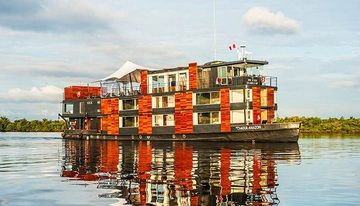
40m | Jordi Puig
from $161,000 p/week
As Featured In
The YachtCharterFleet Difference
YachtCharterFleet makes it easy to find the yacht charter vacation that is right for you. We combine thousands of yacht listings with local destination information, sample itineraries and experiences to deliver the world's most comprehensive yacht charter website.
San Francisco
- Like us on Facebook
- Follow us on Twitter
- Follow us on Instagram
- Find us on LinkedIn
- Add My Yacht
- Affiliates & Partners
Popular Destinations & Events
- St Tropez Yacht Charter
- Monaco Yacht Charter
- St Barts Yacht Charter
- Greece Yacht Charter
- Mykonos Yacht Charter
- Caribbean Yacht Charter
Featured Charter Yachts
- Maltese Falcon Yacht Charter
- Wheels Yacht Charter
- Victorious Yacht Charter
- Andrea Yacht Charter
- Titania Yacht Charter
- Ahpo Yacht Charter
Receive our latest offers, trends and stories direct to your inbox.
Please enter a valid e-mail.
Thanks for subscribing.
Search for Yachts, Destinations, Events, News... everything related to Luxury Yachts for Charter.
Yachts in your shortlist
- Vessels: 209892
- Vacancies: 135
- Registered: 65226

MOSCOW SPIRIT , IMO 9418602
- Current position
- Certificates

| IMO number | 9418602 |
|---|---|
| MMSI | 311000449 |
| Name of the ship | MOSCOW SPIRIT |
| Former names | PRINCIMAR STRENGTH ORIENT PIONEER |
| Vessel type | Crude oil tanker |
| Operating status | Active |
| Flag | Bahamas |
| Gross tonnage | 83850 tons |
| Deadweight | 156480 tons |
| Length | 274 m |
| Breadth | 48 m |
| Engine type | B&W |
| Engine model | 6S70MC-C |
| Engine power | 186645 KW |
| Year of build | 2010 |
| Builder | JIANGSU RONGSHENG HEAVY INDUSTRIES - RUGAO, CHINA |
| Classification society | DET NORSKE VERITAS |
| Home port | NASSAU |
| Owner | PRINCIPAL MARITIME MANAGEMENT - SOUTHPORT CT, United States (USA) |
| Manager | NORTHERN MARINE MANAGEMENT - CLYDEBANK, U.K. |
| Description | MOSCOW SPIRIT is a Crude oil tanker built in 2010 by JIANGSU RONGSHENG HEAVY INDUSTRIES - RUGAO, CHINA. Currently sailing under the flag of Bahamas. Formerly also known as PRINCIMAR STRENGTH, ORIENT PIONEER. It's gross tonnage is 83850 tons. |
| Seafarers worked on | |
|---|---|
| Open vacancies on | No open vacancies on this ship |
| Vessel MLC insurance |
|---|
World’s fastest growing seamen employment service!
- Apply for a vacancy (updated daily) Vacancy list
- How does it work? Learn more
- Receive job opportunities by email
- CHIEF OFFICER
- SECOND OFFICER
- THIRD OFFICER
- FOURTH OFFICER
- TRAINEE OFFICER
- ABLE SEAMAN
- ORDINARY SEAMAN
- SAND BLASTER
- CHIEF ENGINEER
- SECOND ENGINEER
- THIRD ENGINEER
- FOURTH ENGINEER
- TRAINEE ENGINEER
- ELECTRICAL ENGINEER
- GAS ENGINEER
- REEF ENGINEER
- ELECTRICIAN
- TRAINEE ELECTRICIAN
- MOTORMAN/OILER
- MOTORMAN GRADE 2/WIPER
- ELECTRONIC OFFICER
- SUPERINTENDENT
- ENGINE CADET
- ELECTRICAL CADET
- CHIEF STEWARD (-ESS)
- STEWARD (-ESS)
- WAITER (-RESS)
- MESS MAID/BOY
- JUNIOR OFFICER
- CRANE OPERATOR
Upload vessel photos
| Attach files |
Add to block list
Delete note.
Do you really want to delete this note?
Add to a vacancy
E-mail: [email protected]
- Share full article

I Put Up a Fence in Maine. Why Did It Cause Such a Fuss?
The goal was to shield our house from the road, but it soon turned into something much more revealing.
The author, Heidi Julavits, at her home, which was built in 1815. Credit... Fumi Nagasaka for The New York Times
Supported by
By Heidi Julavits
Heidi Julavits is a writer who grew up in Portland, Maine.
- July 15, 2024
When we bought our house in Maine 23 years ago, people welcomed us to town with tales of local mishaps and gaffes. Barns that almost burned down. Pipes that burst. The man a mile down the road who built a fence. This chatty imparting of intel functioned simultaneously as a gesture of hospitality and a comical how-not-to primer, containing valuable survival and etiquette tips. Our town of about 830 residents more than doubles in size during the summer, when part-time residents like me arrive. The fence story suggested what types of behavior on your personal property were, and were not, considered neighborly in a town where zoning ordinances are few.
Listen to this article, read by Kirsten Potter
“You won’t ever get rid of the magazine room, will you?” people asked. The magazine room is on our house’s second floor. It’s basically a vintage mood board, and more of a windowless crawl space than a room, accessible through what looks like a cupboard door. A much earlier resident, or successive generations of earlier residents, had patchworked the pitched, unpainted walls of the magazine room with clippings from what appeared to be fashion, adventure-story and homemaking periodicals dating to the first half of the 1900s.
We promised never to renovate the magazine room.
We promised to change very little about our house, at least what was visible from the road, including the 11-foot-tall deciduous hedge that ran the length of our yard and seasonally blurred our view of the traffic coming in and out of town.

But then the hedge began to fail. An expert from a nearby nursery arrived with a clipboard and pronounced our hedge an invasive, nonnative weed, not worth saving. But we loved the weed. We topped it. We fertilized it.
It was on the leisurely upswing when, 16 years after we bought our house, a woman driving a fancy S.U.V. jumped the culvert, plowed through the hedge, jumped the culvert again and sped off. Had the man behind her not followed her home, she might have tried to get away with her (as everyone agreed) very impressive stunt driving.
We weren’t in town at the time, and so could only view photographic evidence of the damage: the gouged earth, the long hedge like a smile missing some of its teeth. Our reaction was impulsive and in retrospect, baffling: We would use the money we received from the stunt driver to put up a fence.
Even one year earlier, we might have planted a new hedge, possibly even a native one. But the person driving over our front lawn felt like a slapstick escalation of a recent trend I had observed. Previously, living on our road was like living on the ocean, but with much lower property taxes; its perils could be charted and managed, like the tides. But then the unofficial speed limit outside our house increased from 35 m.p.h. to 45, even occasionally 50. At this time, I had younger children, and many friends with young children, and a trampoline in the backyard that, even if we weren’t home, was “open” to bouncing enthusiasts, which sometimes included middle-aged men when the neighborhood threw parties. The slight curve near our driveway made it difficult to see cars coming at higher speeds, which meant even adults, people arguably in possession of better judgment than a 7-year-old, were nearly hit a few times trying to leave on a bike.
At first, I accepted (even embraced!) the road as my problem to solve, and thus I indulged many energizing, problem-solving fantasies. I would pay my daughter to wear a cop costume and stand at the end of our driveway and point a hair dryer, which at high speeds would register as a radar gun, at oncoming cars. I would put up the sort of signs that make me slow down. FREE STUFF. YARD SALE. I would buy a baby doll, strap it into a stroller and leave the stroller in the middle of the road.
But I also felt resigned to a foregone fate. The intensifying situation on the road, I suspected, was the natural progression of an economic agreement struck more than a century ago between transportation advances and Maine as a nonexportable resource. The state’s slogan “Vacationland” first appeared on car license plates in 1936 and still appears on the Maine border sign that greets drivers as they enter via I-95, the state’s primary national highway. But Maine’s identity as a seasonal purification rite for urbanites dates further back than even the invention of cars, to the years following the Civil War.
I’m neurotically attuned (some might say) to this history’s lingering rumbles. I was born and raised in Maine, and so I’ve been versed since my earliest moments of sentience in Maine’s identity as something both staunchly fixed and, during the summer months, menaced from all directions, including the sea, by visitors — “From Aways.” While my parents moved to Portland in 1965, after which my brother and I were born, we were also, according to some measures of nativeness, invaders ourselves. Rather than “Mainers Who Can Trace Their Mainerness Back Through Many Generations of Other Mainers Who Lived Only in Maine,” my parents, and by eventual extension my brother and I, were the type of Mainer defined as “Year-Round Resident, Seasonally Irritated.”
Yet my father was and is Mainer enough that this history still irks him. He recently, while visiting, groused of summer people (to me, now technically a summer person), “They showed up thinking we should adapt to their ways, rather than them adapting to ours.” His frustration was not about “us” demanding compliance, and failing to get it, from part-time residents or tourists; he was reacting to the outsiders’ hubristic refusal to value local knowledge that a person might share as a form of wary welcome.
He and my mother still love to tell the story that they heard from friends of an 1980s invasion by the New York Yacht Club, when their annual summer cruise came to Maine. The story, which the Yacht Club denies ever happened, has to me the true-ringing feel of what was then a century’s worth of encounters between Mainers and summer people, efficiently condensed into a colorful how-not-to tale. The club members, ignoring the cautions from local bystanders, piled onto a dock as if it were a commuter-train platform and waited for a launch to take them to their individual yachts, presumably sailed north for them by hired captains. The dock float sank lower and lower and finally swamped, dumping into the harbor the club members, some of whom had flown to the Portland International Jetport straight from New York in their business suits and were still, when they hit the ocean, holding their briefcases.
During the summer of 2016, when the speed of cars driving past our house was frequently 10 to 15 m.p.h. above the posted limit, I did something I’d never done before. I complained. I visited the town selectmen, one of whom asked, “Are you related to Bill?” He and my father worked together, we eventually determined, back in the ’90s. This is how encounters tend to start in a state with just over a million people, in a town with just under a thousand people, when you have a last name that not even your close childhood friends can spell.
The selectmen were sympathetic to the speeding issue — I was not the first to complain, and nor were these complaints coming only from seasonal residents — but their message of thoughtful, if cautious, consideration reflected those I’d encountered in casual conversation. Possibly, the town’s attitude toward speeding was like the attitude toward zoning laws, or the ongoing lack of them — a respectful attempt to manage new civic challenges while preserving the state’s historical spirit of self-determination.
My husband and I honored that spirit after the stunt driver busted through our hedge. Our small son, when informed about our plans to build a fence, stared melancholically through the ragged gap, as if we’d just told him that we intended to continue the damage that the stunt driver had only begun — which in a sense, we had.
“Only depressed people build fences,” he said.
We didn’t lecture him on the difference between depression and anxiety, between anxiety and acute situational awareness, between acute situational awareness and instant, awful death, because first we needed to fully kill the hedge we had spent nearly a decade trying to save. Then we needed someone to install the fence. We settled on a fence company located a little over an hour away. The reviews were good. Their customers — whoever they were, and in whatever bizarre, fence-loving towns they lived — seemed happy.
But as we scrolled through fence styles online, none seemed like the obvious choice. My inability to know which fence was the right fence should have suggested: There was no right fence. True, I was not fluent in the language of fences. I didn’t know how tall a fence should be. I didn’t know what kind of fence would look best with our house, because our house, and most houses like it, did not have fences marking a property boundary. Maine was more of a “sign” place. This was how you knew you were crossing, or trespassing, a border.
Signs change, however; or maybe it’s more accurate to say that the messages on signs do. Despite what would seem to be its wild success, the “Vacationland” state slogan was updated in 1987 by Maine’s Office of Tourism to “The Way Life Should Be.” (A giant sign posted on I-95 near Kittery read in full, “Welcome Home/The Way Life Should Be.”)
This new slogan, while on its surface more breezily aspirational, caused perplexity, and signaled different things to different people. If, for example, a person had recently met with their local elected officials, they might think that Maine, as a matter of no-frills pragmatism (and increasingly, it seemed, as a marketing virtue) wasn’t hampered by the sometimes-unnuanced oversteps of federal governance. Others might find the slogan puzzlingly out of touch, given that poverty rates were on the rise; what, too, might the slogan imply in a state whose racial demographics were 98 percent white? Others might worry the slogan could risk insulting tourists, presumably the target audience, about their way of life.
“The Way Life Should Be,” depending on the song that happened to be playing in your car after you drove over the border and first beheld the welcome sign, could also thrum with minor-key warning: Don’t come here thinking that things need to change.
But one thing that kept changing was the state’s highway signage. Gov. Angus King, an independent who held office from 1995 until 2003, installed two additional signs flanking I-95, “Maine. Worth a Visit. Worth a Lifetime” — the equivalent of a person seeding your subconscious as you entered the state and then handing you a tempting real estate listing as you left. Later, in 2011, Gov. Paul LePage, a Republican, sharpened King’s suggestive soft sell into what sounded like a deregulated fire sale by attaching, beneath the original northbound sign, a supplemental message. Now it read, “Welcome to Maine/The Way Life Should Be/OPEN FOR BUSINESS.”
Our choice of fence may have abided by some, all or none of these slogans. Seven feet tall, the fence was solid, not lattice-y, made of vertical cedar tongue-and-groove boards. (The invoice we received from the fence company bluntly itemized it as a “privacy panel.”) We had decided that if we were going to build a fence, we should seize the chance not to see cars, and to muffle the rise and fall of their engines. Before the stunt-driver incident, some friends were visiting with their dog when it ran into the road and was killed. (My father, standing in our yard at the time, said, “At least it wasn’t a kid.” He might have tabled this observation for a few hours or weeks, but he wasn’t wrong.) At that point, I was still hearing a large animal being struck every time a car drove by, especially because of what my father had said: The dog might have been a kid.
The fence we chose was topped by a mini-fence detail that ran the length of it, to visually soften the highway-sound-barrier vibe. The cap rail read “fence” in the way the fence did not, which further suggested: This fence was not only a fence. It was also an overreaction — a fearful response to what might have happened, rather than what did. And if the fence was meant to decrease the chances that a person might drive into the yard again, or that one of us might be hit on the road, it did not make us safer from either threat.
I wasn’t home the day the fence was installed. I left in the morning, and by the time I returned, it was there. It was far too tall for our tiny house behind it. It was an unweathered cedar slab, practically neon-yellow when the sun hit it. It gave me an awful feeling of remorse in the pit of my stomach from the moment I first saw it.
The fence caused an immediate stir, which I found highly distressing, but also affirming, because I agreed with the dissenters, some of whom were my dear friends. Other members of the community conveyed their feelings publicly, in writing. Our town is home to at least one, and maybe more, anonymous activists who express their opinions via handmade signs; they’re like an online comments section, posted high — often very high — in the air. One of these commenters posted a sign on the road, just north of our house, which, on the plus side, possibly caused the average speed limit to temporarily decrease. TRUMP’S BORDER WALL 1 MILE AHEAD. The sign was nailed to the top of an electrical pole; the inability to remove it without a bucket truck reinforced the permanence of the opinion.
At first, this message, much like “The Way Life Should be,” contained a multiplicity of possible readings. What might, however, initially be interpreted as a protest by a left-wing resident was in fact — at least I think it was — in 2017 a much more layered calling-out of our presumed liberalism, as city-dwelling From Aways. If so, I took their point. Look at these hypocritical people who are probably opposed to Trump’s wall, putting up a wall.
After the initial furor died down, circumspect friends would say, consolingly, “It’ll gray up eventually.” One or two congratulated me. I had every right to build a fence. Others refused to countenance my regret. When I shared my thoughts about future plants or bushes that might take the fence’s place, should it magically disappear, one person said, “I think you have to accept the fact of the fence.”
These varied responses summed up the paradox of the fence. It was the most From Away thing I could have done; it was also the most Maine thing I could have done. People were discouraged from building fences, but because it was our property, nobody had the right to tell us what we could do on it.
This also probably explained why no one vandalized the fence, even though it was a long, blank canvas that honestly might have looked a little cheerier with a hit of spray paint. It was my psychological boundary line made material. People respected it. In some ways, they respected it too much. The fence altered our social weather patterns. Before the fence, friends and acquaintances would stop by regularly. After we built the fence, these impromptu visits slowed. Some people started to text beforehand to announce they’d be dropping by, or to ask if it was OK; they suddenly felt they needed permission to see us.
As the summer wound down, acquaintances and friends would ask ribbingly, “How’s your wall?” Most people had an opinion, or a teasing-yet-not comment, which at a minimum illustrates how visible our house is and how many people drive past it.
Yet on the plus side, which I strove to see, we were becoming the future tale to be told to newcomers; our fence, and the community response to it, would be entered in the oral history, and we would be immortalized. It wouldn’t be the first time: After taking ownership of our house in 2001, we wasted no time starring in a cautionary story about arrivals to town who didn’t know much. Our very first winter, we turned off the breaker to the sump pump instead of the well pump, and then there was a violent rainstorm, then the basement flooded, then the furnace became submerged and broke, then the temperature plummeted, then the pipes burst, then the well pump continued to empty the well water into the dining room, and because our foundation slumps toward the woods, then the water flowed out below the roofline and formed a thick, frozen waterfall on the exterior wall that threatened to pull down the back half of the house.
Not for the last time, we were a source of comedic incompetence; we had failed to understand how winter works, and how water works, and how electricity works. But the story of the fence was proof of a different, more publicly visible failure to understand. Or worse: understanding, but not caring.
We did care. This made the fact of the fence inscrutable even to us. Not even a year after building the fence, my husband stood outside one evening, assessing it with a look of bewilderment. “I don’t know why we did that,” he said.
The following summer, we planted a row of native, climbing hydrangeas to cover the exterior of the fence in green so that, to those driving by even at moderate speeds, it might be indistinguishable from the previous hedge. The hydrangeas grew quickly, but not quickly enough. I found myself caught between guilt and annoyance when greeted by someone with another “wall” joke. If the people who lived in town weren’t thrilled with the fence, they had every good reason to feel that way, because we’d permanently altered their view; also, they had learned to coexist with the road without building a fence, so why couldn’t we?
I had less patience for the seasonal people who lived on the water, far from the busy road. They were cranky that their scenic drive to the grocery store had been changed; they could no longer be cleansed by the preindustrial beauty of Maine as they sped past our old farmhouse to buy food. I had to hold my tongue when a patrician summer person who lived on the coast, down two private dirt roads, announced to me, “It is a person’s community duty not to change the front of their house.”
Which sentiment I did not entirely disagree with. Our house, for example, was both ours and not. For nearly a decade, our house was referred to by the former owner’s name; for the FedEx delivery person to find us, we had to repeatedly clarify that we lived in their house. In our town, maybe in many small towns, the houses are a way of recording recent human history. Our house was communal property, in a sense; a public holding of the historical society.
This was also why we were so committed to preserving the magazine room. It functioned as a museum to the generations who preceded us. I often took visitors up to see the clippings, though the room had become harder and harder to access. First there were five, then 10, then 15 years’ worth of books and clothing barricading entry. Only the most agile person could squeeze past the threshold, or a committed, bushwhacking person like my daughter, who always found a new cache of clothes that interested her as the fashion trends in her present made renewably relevant the leftovers of our past, which we had stuffed into trash bags and taken to hurling from the doorway into the middle of the room.
Yet questions of preservation — and how a slogan like “The Way Life Should Be” might freeze a place in time, or raise questions of what should be, rather than what is — could, depending on your interpretation, suggest a widespread consensus that never existed. In 2019, Gov. Janet Mills, a Democrat, replaced LePage’s “Welcome to Maine/The Way Life Should Be/OPEN FOR BUSINESS” with, simply, “MAINE/Welcome Home.” (Three months later Mills added back the 1987 slogan; the sign currently reads “MAINE/Welcome Home/The Way Life Should Be.”) This latest tweak might announce the state’s increased openness, not just to seasonal visitors but also to people relocating from other states and countries. It might be an exhortation for residents, new and old, to consider the state not as a fixed entity but as an increasingly porous and diverse one, built atop a sturdy foundation of resourcefulness and autonomy.
The responsibilities a newcomer might have, or not have, in a place they call home, even for part of the year — these are questions that I think about constantly. When is inaction in the name of respect, or preservation, an abnegation of civic duty? When is preservation used as noble cover to forbid new people’s access to a place? When is a newcomer’s confident sense of what should be actually an imposition of their values?
But “Welcome Home/The Way Life Should Be” is also the epigraph to every person’s childhood memories, assuming they associate home with happiness. That nostalgia — also the sense of melancholy or outrage — can intensify in direct proportion to the amount of change that has happened to your home since you left it.
The fence is seven years old now, but it is still occasionally a source of friendly teasing. Last winter, I drove up alone, and arrived after dark, and left my car in the road so I could move a branch that had fallen across the driveway. A friend pulled up beside me and said, smiling, “Are you locked out of your compound?”
Each passing year also deepens a paradox; to add more months to the time I’ve spent in Maine adds more months to the time I’ve spent not in Maine. If time is the singular measure, the longer I live in Maine, the more of a From Away I become.
Yet even when I’m not in Maine, I represent a demographic causing an increasingly dire housing crisis. Mills’s welcome sign became prophetic; during the pandemic, people from out of state bought places that had been on the market for years, in some cases more than a decade.
In 2019, the average sale price in our county was down about 25 percent from the previous year. But between 2020 and 2021, the average sale price increased by almost 41 percent. Our house, for years a depreciating-to-stagnant money pit, was suddenly worth so much that we might have nearly broken even had we decided to sell; but the price point would dictate that buyer would probably be a From Away, and a well-off one.
This trend extends beyond our county. In May, Portland, my former hometown, was named the “hottest luxury housing market in the United States” for the third quarter in a row, its prices up 22 percent from 2023. And yet, despite the rise in housing costs and the state’s evolving national appeal — from wilderness idyll for those who enjoy freezing water, no-sand beaches and insect sieges to a differently commodified version of escape — certain local numbers might suggest that little has changed. The number of children in the public elementary school has remained roughly the same. The town voting rolls haven’t increased much; there were, however, 30 or 40 more car registrations during the pandemic.
Some in town seem invested in change, and more of it may be on the horizon. Given that the community isn’t a monolith and never was, these shifts are not unanimously viewed as either losses or improvements. A committee formed to consider hiring a harbor master. The anonymous sign-posters were busy again when the selectmen decided to no longer allow an annual ritual in which people drag busted docks and boats and appliances into the center of town and host a gathering late into the night, after which, at dawn, a man with a crane takes the junk pile to the dump. Some of the signs were historically indignant: “100+ YEAR … TRADITION.” Others, hung on top of electrical poles, were more taunting: “NICE TRY SELECTMEN.” Others spoke to a broader crisis: “WHAT ELSE IS THERE TO DO?”
The town installed a permanent speed monitor, which I believe is meant to flash when a person is driving above the posted limit, but it’s hard to know for certain. The current monitor is actually the second of its kind, because the original sustained a fatal shooting, and the new one soon acquired half a dozen bullet holes, and so doesn’t work either. The monitor, in alerting nobody to anything save someone’s opposition to it, was maybe more a public referendum on speed management than a speed-management strategy.
Other things are changing, too. The magazine room, like the hedge before it, is failing. Allowing a thing to simply be, it turns out, is a slow path to its extinction. The uninsulated space heats up these days to what must be over 100 degrees during the summer, and for that reason I tend not to go there, and so was surprised to find, while we were supposedly preserving it, that the magazine room is in ruins. The glue is decomposing; the desiccated clippings, when touched, turn to dust. Someday, the walls will be bare.
Our fence, meanwhile, has weathered to a medium-dark gray. The climbing hydrangeas look like goofy, bungling creatures, their paws pushing through the railings on top of the fence, so that I can see them even when I’m behind it. Their invasion is a welcome one. I’ve started to wonder whether if, in the future, the person who owns this house decides to take the fence down, such a decision will prove controversial; might the fence, a once-glaring newcomer, be considered part of the town’s history and thus, like the magazine room, qualify for protection? If nothing else, and in the meantime, will people wish to preserve the tradition of teasing us about it?
I might even wish to preserve that tradition. The familiar ribbing — “How’s your wall?” — is practiced by fewer and fewer people, to the point that now it feels like an affectionate and even nostalgic way of greeting me after I’ve been away. The once-habitual exchange preserves a record, the way the historical society preserves photos of buildings and residents that no longer exist, of the occasional challenges of coexistence, even or especially among well-meaning people who like and respect one another.
One day last summer, as I was standing at the end of my driveway, a woman I’d never seen before walked by. She might have been a new resident, or someone’s guest, or a person on vacation. I experienced an odd mixture of relief and sorrow when she smiled at me and said, “That is such a beautiful fence.”
Heidi Julavits is a writer whose recent memoir is “Directions to Myself.” Fumi Nagasaka is a photographer in New York whose work over the last few years has focused on documenting America. For this assignment, she traveled to three different towns in Maine.
Read by Kirsten Potter
Narration produced by Emma Kehlbeck and Krish Seenivasan
Engineered by Lance Neal
Explore The New York Times Magazine
A Controversial Fence in Maine: The goal was to shield a house from the road, but it soon turned into something much more revealing .
Robert Putnam Knows Loneliness: The author of “Bowling Alone” warned us about social isolation and its effect on democracy a quarter century ago. Things have only gotten worse .
The Diddy She Remembers: Looking back on her life as a woman in the music industry, Danyel Smith is unsettled by the sexism perpetrated by Sean Combs and others .
A Wrongful Conviction: Flawed science helped convict a man more than 20 years ago, but the Nashville D.A.’s office now says it got it wrong. Why is he still behind bars ?
An Inescapable Kidnapping: Fifty years ago, he was taken at gunpoint. Then he went on with his life — and that’s the part that haunts Taffy Brodesser-Akner .
Advertisement
- MOSCOW SPIRIT
Crude Oil Tanker, IMO 9418602
- VesselFinder
The current position of MOSCOW SPIRIT is at South America West Coast reported 19 days ago by AIS. The vessel arrived at the port of Talcahuano Anch., Chile on Jul 2, 21:12 UTC. The vessel MOSCOW SPIRIT (IMO 9418602, MMSI 311000449) is a Crude Oil Tanker built in 2010 (14 years old) and currently sailing under the flag of Bahamas .
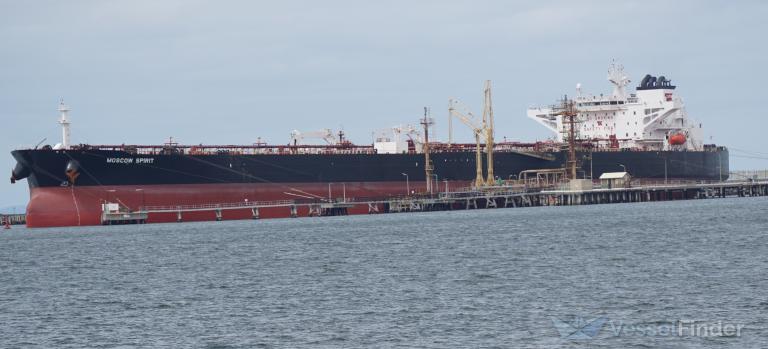
Position & Voyage Data
| Predicted ETA | - |
| Distance / Time | - |
| Course / Speed | |
| Current draught | 8.8 m |
| Navigation Status | - |
| Position received | |
| IMO / MMSI | 9418602 / 311000449 |
| Callsign | C6CE5 |
| Flag | Bahamas |
| Length / Beam | 275 / 48 m |
Map position & Weather
Recent port calls, vessel utilization, vessel particulars.
| IMO number | 9418602 |
| Vessel Name | MOSCOW SPIRIT |
| Ship type | Crude Oil Tanker |
| Flag | Bahamas |
| Homeport | |
| Gross Tonnage | 83850 |
| Summer Deadweight (t) | 156480 |
| Length Overall (m) | 274 |
| Beam (m) | 48 |
| Draught (m) | |
| Year of Build | 2010 |
| Builder | |
| Place of Build | |
| Yard |
| TEU | - |
| Crude Oil (bbl) | |
| Gas (m3) | - |
| Grain | - |
| Bale | - |
| Classification Society | |
| Registered Owner | |
| Owner Address | |
| Owner Website | - |
| Owner Email | - |
| Manager | |
| Manager Address | |
| Manager Website | |
| Manager Email |
Similar vessels
| Vessel | Built | GT | DWT | Size (m) |
|---|---|---|---|---|
| 2010 | 83850 | 156493 | 274 / 48 | |
| 2011 | 83850 | 156639 | 274 / 48 | |
| 2011 | 83850 | 156532 | 275 / 48 | |
| 2009 | 83850 | 156643 | 274 / 48 | |
| 2012 | 83850 | 156597 | 274 / 48 | |
| 2012 | 83824 | 160024 | 274 / 48 | |
| 2012 | 83824 | 160152 | 274 / 48 | |
| 2013 | 83882 | 154107 | 274 / 49 | |
| 2013 | 83882 | 154036 | 274 / 49 | |
| 2013 | 83882 | 154233 | 274 / 49 |
Related news
MOSCOW SPIRIT current position and history of port calls are received by AIS. Technical specifications, tonnages and management details are derived from VesselFinder database. The data is for informational purposes only and VesselFinder is not responsible for the accuracy and reliability of MOSCOW SPIRIT data.
SPIRIT SY111
REALISING THE DREAM
“Build a work of art”. The brief from the owner of the Spirit 111 Geist had beauty and soul at its heart.
A completely custom project, the design of the yacht began with a collaboration between Spirit Yachts and Rhoades Young. Jonathan Rhoades commented, “The brief was a combination of his love for furniture and organic architecture. The client had recently visited Antelope Canyon in Arizona and this was the catalyst for the idea of the warm soft flowing walls creating unique focal points within the room.”
Spirit Designer Sean McMillan added, “There was to be no straight lines or objects that interrupted the ‘flow’ of the sweeping timber curves. Once the aesthetics were established, the primary design challenge was marrying the beauty of the interior with the operation of the yacht. After Rhoades Young had delivered the initial ‘S’ shaped concept for the interior, it was our task to bring the design to life and ensure it could be accomplished by the build team. The visual side of the brief made the importance of ‘hidden’ technical spaces even more acute given the amount of systems and engineering on such an advanced yacht. The curves of the interior not only had to look seamless, they also had to house the functional elements of the yacht and be accessible. Hidden recesses and sensors became integral for disguising storage and technical spaces (even door handles were replaced with secret hand-activated sensors to ensure the doors remained seamless panels). As well as looking like a “work of art”, the interior of the yacht also had to comply to RINA’s exacting classification requirements. This marriage of practicality, safety and beauty to deliver on the owner’s brief made the project a thrilling challenge.”
Geist’s owner added, “I have owned a Spirit 52 for ten years and during this time I have grown to implicitly trust and respect the team at Spirit Yachts. I knew they would listen to my ideas and I was confident they had the skills to execute the project. The result is Geist: a very special yacht, a dream come true. The aesthetics of the yacht, inside and out, were always of paramount importance. Closely followed by the aim of being as self-sufficient as possible and minimising the impact on the environment. In most larger yachts, space is gained at the cost of detaching yourself from nature. In Geist, I wanted beauty to take precedence over practicality.”
SPIRIT SY111 SUPERYACHT AT A GLANCE
Specification & features.
- L.O.A 111' 3" / 33.90m
- L.W.L 78' 9" / 24m
- Beam 21' 0" / 6.40m
- Draft 13' 3" / 4.05m
- Lightship Displacement 75.8 tonnes
- Ballast Ratio 45%
- Propulsion 100kW electric shaft drive
- Upwind Sail Area 450 m2
- Rig Fractional Bermudan Sloop
- Keel Iron Blade 8390kg – Lead Bulb 16585kg
- Classification Society RINA (private use – unrestricted navigation)
- RINA Suggested Max Persons 10
TIMELESS ELEGANCE
Spirit Yachts’ contemporary, elegant design style is world renowned. Subtle variations on 1930s classic yacht design with long overhangs, low profiles and smooth lines, married to contemporary underwater profiles, are synonymous with Spirit’s modern classic performance yachts.
Spirit Yachts are designed to be as beautiful in 100 years as they are today.
SIMILAR YACHTS
Spirit sy100, make an enquiry.
" * " indicates required fields

IMAGES
COMMENTS
Spirit Yachts' contemporary, elegant design style is world-renowned. Subtle variations on 1930s classic yacht design with long overhangs, low profiles and smooth lines, married to contemporary underwater profiles and the latest technology, are synonymous with Spirit's modern classic cruising, racing, and power yachts. Spirit yachts are designed to be as beautiful in 100 years as they are ...
Spirit Yachts' flagship modern classic motor yacht, the Spirit P70, was designed for an experienced motor yacht customer who requested an owner-driven yacht capable of cruising 1,000nm at an average of 18 knots across the North Sea without having to refuel. As with all Spirit yachts, the P70 has been completely customised to suit the owner ...
Spirit Yachts is globally recognised for its modern classic yachts and has built a reputation for classic style complemented by quality and performance. This website stores cookies on your computer. These cookies are used to improve your website experience and provide more personalized services to you, both on this website and through other media.
It took three painters seven months to varnish the interior. Courtesy Spirit Yachts. The price of a new P70 starts at £4 million, or roughly $5.5 million. The Spirit P70 looks like a boat from ...
Spirit Yachts put its toe in the water with larger yachts when the 100ft Gaia was launched in 2007, but there were issues, especially in race mode upwind, when her timber hull deflected marginally ...
Suffolk-based yard Spirit Yachts has delivered its 21.7 metre motor yacht flagship, the P70. The yacht, which is the largest motor yacht ever built by the yard, previously hit the water at the Ipswich based yard last year. The handover of the P70 follows the delivery of the 33.9 metre flagship Spirit 111 sailing yacht earlier this year.
SPIRIT, the 54.3M Amels superyacht for charter, is a world cruiser designed for free spirits that harmoniously combines zen and adventure. She accommodates 11 guests in five staterooms and is available in the Caribbean and Central America. She boasts a contemporary interior and spacious decks, as well as an impressive range of water toys for ...
SPIRIT Amels | From EUR€ 255,000 /wk. SPIRIT. Launched in 2011, motor yacht SPIRIT is a 54.30-metre displacement Amels Limited Editions 177, built by the prestigious shipyard Amels in Vlissingen (Holland). Superyacht Spirit features naval architecture by Amels themselves and exterior design by Tim Heywood. Her light and contemporary interior ...
Description. Spirit Yachts' flagship modern classic motor yacht, the Spirit P70, was designed for an experienced motor yacht customer who requested an owner-driven yacht capable of cruising 1,000nm at an average of 18 knots across the North Sea without having to refuel. As with all Spirit yachts, the P70 has been completely customised to suit ...
The 54.3m/178'2" motor yacht 'Spirit' by the Dutch shipyard Amels offers flexible accommodation for up to 11 guests in 5 cabins and features interior styling by Italian designer Nuvolari Lenard. Built in 2011, Spirit boasts a multitude of decks ideal for relaxation and entertainment indoors or outdoors, ensuring guests will live la dolce vita on the open waters.
Crafted from sustainable timber using Spirit's wood-epoxy construction technique, the P40 is a performance cruising motor yacht weighing only 4.5 tonnes. Whilst the P40 has slightly less volume than production yachts of her size, the loss in volume is a major gain in performance.
Lineup. exclusive Spirit Yachts builds sailing yachts from 11 to 30 m in length, entirely of wood. Model range divided into line Classic, Deckhouse and Cruising. Are separately superyacht Spirit of 100 or more feet. Every boat, and all of them built more than 60, is a work of art, with a corresponding cost.
Spirit Yachts is a yacht brand that currently has 4 yachts for sale on YachtWorld, including 0 new vessels and 4 used yachts, listed by experienced yacht brokers and boat dealerships mainly in the following countries: United Kingdom and Italy. YachtWorld offers a diverse array of models, showcasing a comprehensive range of sizes and lengths ...
Speed. 15.5KT. Volume. 656GT. Effortless Afloat. More beach house than floating palace; to stay on board is to feel infinitely connected to the ocean, yet completely at home. Spirit shares the characteristically fluid deck spaces and stretched out sun deck of the Amels Limited Editions models. Sun lovers can rejoice with a choice of outdoor ...
The yacht SPIRIT was built by Amels in 2011. She is designed by Tim Heywood Design Design.. Specifications. The yacht is powered by MTU engines.Her max speed is 16 knots. Her cruising speed is 14 knots. She has a range of more than 3000 nm. Interior. The luxury yacht can accommodate 12 guests and a crew of 13.. Who is the Owner of the Yacht SPIRIT?
The 39.62m/130' motor yacht 'Free Spirit' (ex. Oras) was built by Westport Yachts in the United States at their Westport, WA shipyard. Her interior is styled by American designer design house Westport Yachts and she was completed in 2007. This luxury vessel's exterior design is the work of Gregory Marshall and she was last refitted in 2019.
Q88 LLC is the leading SaaS technology provider to the maritime industry. Our partnership with the world's leading ship owners, charterers, ship managers, agents and brokers has provided us insight into how to build solutions for some of the industry's most pressing issues.
Spirit power yachts are designed to deliver the classic aesthetic of Spirit's iconic sailing yachts with efficient speed on the water and a luxury guest experience. As with all Spirit yachts, sustainably sourced timber, world-class craftsmanship and customisation are at the heart of Spirit power yachts. Each yacht is designed and built to ...
Manager. NORTHERN MARINE MANAGEMENT - CLYDEBANK, U.K. Description. MOSCOW SPIRIT is a Crude oil tanker built in 2010 by JIANGSU RONGSHENG HEAVY INDUSTRIES - RUGAO, CHINA. Currently sailing under the flag of Bahamas. Formerly also known as PRINCIMAR STRENGTH, ORIENT PIONEER. It's gross tonnage is 83850 tons. Seafarers worked on.
The club members, ignoring the cautions from local bystanders, piled onto a dock as if it were a commuter-train platform and waited for a launch to take them to their individual yachts, presumably ...
Spirit Yachts comprises an award-winning team of craftsmen and women who are committed to showcasing the beauty of wood. Whether its strong Mahogany Sipo ringframes, exposed Douglas fir hull planking or bespoke cabinetry pieces, a Spirit yacht celebrates the natural properties of sustainably-sourced timber. Explore Craftsmanship.
The current position of MOSCOW SPIRIT is at South America West Coast reported 4 days ago by AIS. The vessel MOSCOW SPIRIT (IMO 9418602, MMSI 311000449) is a Crude Oil Tanker built in 2010 (14 years old) and currently sailing under the flag of Bahamas . Plans & Prices. Track on Map Add Photo. Add to fleet.
Spirit Yachts' contemporary, elegant design style is world renowned. Subtle variations on 1930s classic yacht design with long overhangs, low profiles and smooth lines, married to contemporary underwater profiles, are synonymous with Spirit's modern classic performance yachts.
Vessel MOSCOW SPIRIT is a Crude Oil Tanker, Registered in Bahamas. Discover the vessel's particulars, including capacity, machinery, photos and ownership. Get the details of the current Voyage of MOSCOW SPIRIT including Position, Port Calls, Destination, ETA and Distance travelled - IMO 9418602, MMSI 311000449, Call sign C6CE5